| Revision as of 12:01, 19 June 2005 editSolipsist (talk | contribs)Extended confirmed users17,504 editsm Reverted edits by 195.93.21.98 to last version by Sparkit← Previous edit | Latest revision as of 19:06, 3 December 2024 edit undoFilmssssssssssss (talk | contribs)Extended confirmed users, Pending changes reviewers, Rollbackers34,629 editsm Reverted edits by 72.45.198.98 (talk) to last version by AP 499D25Tag: Rollback | ||
| Line 1: | Line 1: | ||
| {{Short description|French artist (1869–1954)}} | |||
| ] | |||
| {{Redirect|Matisse}} | |||
| {{too many sections|date=August 2024}} | |||
| {{EngvarB|date=December 2013}} | |||
| {{Use dmy dates|date=October 2022}} | |||
| {{Infobox artist | |||
| | image = Henri Matisse, 1913, photograph by Alvin Langdon Coburn.jpg | |||
| | caption = Matisse in 1913 | |||
| | birth_name = Henri Émile Benoît Matisse | |||
| | birth_date = {{Birth date|df=yes|1869|12|31}} | |||
| | birth_place = ], France | |||
| | death_date = {{Death date and age|df=yes|1954|11|3|1869|12|31}} | |||
| | death_place = ], France | |||
| | spouse = {{marriage|Amélie Noellie Parayre|1898|1939|end=div}} | |||
| | children = 3 | |||
| | movement = ], ], ] | |||
| | awards = | |||
| | patrons = ], ], ], ], ], ] | |||
| | field = {{hlist|Painting|]|sculpture|drawing|]}} | |||
| | training = {{Lang|fr|]|italic=no}}, ], ] | |||
| | works = '']'' (1905)<br />'']'' (1906)<br />'']'' (1907)<br />'']'' (1909)<br />'']'' (1911)<br />'']'' (1953) | |||
| |module={{Infobox person|child=yes | |||
| | signature = Matisse autograph.svg}} | |||
| }} | |||
| '''Henri Émile Benoît Matisse''' ({{IPA|fr|ɑ̃ʁi emil bənwa matis|lang}}; 31 December 1869 – 3 November 1954) was a French ], known for both his use of colour and his fluid and original draughtsmanship. He was a ], ], and ], but is known primarily as a painter.<ref>{{cite journal|last=Myers|first=Terry R.|date=July–August 2010|title=Matisse-on-the-Move|url=http://brooklynrail.org/2010/07/artseen/matisse-on-the-move|journal=The Brooklyn Rail}}</ref> | |||
| '''Henri Matisse''' (], ] – ], ]) was a ] ]. | |||
| Matisse is commonly regarded, along with ], as one of the artists who best helped to define the revolutionary developments in the visual arts throughout the opening decades of the twentieth century, responsible for significant developments in painting and sculpture.<ref>{{cite web|title=Tate Modern: Matisse Picasso|url=http://www.tate.org.uk/whats-on/tate-modern/exhibition/matisse-picasso|access-date=13 February 2010|publisher=Tate.org.uk}}</ref><ref>{{cite news|author=Adrian Searle|date=7 May 2002|title=Searle, Adrian, ''A momentous, tremendous exhibition'', The Guardian, Tuesday 7 May 2002|work=Guardian|location=UK|url=https://www.theguardian.com/culture/2002/may/07/artsfeatures|access-date=13 February 2010}}</ref><ref>{{cite web|title=Trachtman, Paul, ''Matisse & Picasso'', Smithsonian, February 2003|url=http://www.smithsonianmag.com/arts-culture/matisse-amp-picasso-75440861/?no-ist|access-date=13 February 2010|publisher=Smithsonianmag.com}}</ref><ref>{{cite news|date=1 December 2004|title=Duchamp's urinal tops art survey|publisher=news.bbc.co.uk|url=http://news.bbc.co.uk/2/hi/entertainment/4059997.stm|access-date=10 December 2010}}</ref> | |||
| Influenced by the works of ], ] ] and ], and also by traditional ], Matisse painted in the ] manner, and became known as a leader of that movement. | |||
| The intense colourism of the works he painted between 1900 and 1905 brought him notoriety as one of the ] (] for "wild beasts"). Many of his finest works were created in the decade or so after 1906, when he developed a rigorous style that emphasized flattened forms and decorative pattern. In 1917, he relocated to a suburb of ] on the ], and the more relaxed style of his work during the 1920s gained him critical acclaim as an upholder of the classical tradition in ].<ref>Wattenmaker, Richard J.; ], et al. (1993). ''Great French Paintings from the Barnes Foundation''. New York: Alfred A. Knopf. {{ISBN|0-679-40963-7}}. p. 272</ref> After 1930, he adopted a bolder simplification of ]. When ill health in his final years prevented him from painting, he created an important body of work in the medium of cut paper ]. | |||
| He painted with blaze of intense shades, flat shapes and controlled lines, with expression dominant over detail. He depicted mostly domestic scenes and figures. | |||
| His mastery of the expressive language of colour and drawing, displayed in a body of work spanning over a half-century, won him recognition as a leading figure in ].<ref> Retrieved 30 June 2010.</ref> | |||
| Working in a number of modes, but principally as a ], Matisse was one of the few artists to achieve widespread fame during his lifetime. | |||
| ==Early life and education== | |||
| He was born '''Henri-Émile-Benoît Matisse''' in ], ], France, and grew up in ]. In ] he went to ] to study law, after which worked as a court administrator in ]. | |||
| ]'' (''La Liseuse''), 1895, oil on board, 61.5 x 48 cm, ], ]]] | |||
| Matisse was born in ], in the ] ] in Northern France on ] in 1869, the oldest son of a wealthy ].<ref>Spurling, Hilary (2000). ''The Unknown Matisse: A Life of Henri Matisse: The Early Years, 1869–1908''. University of California Press, 2001. {{ISBN|0-520-22203-2}}. pp. 4–6</ref> He grew up in ], ]. In 1887, he went to ] to study law, working as a court administrator in ] after gaining his qualification. He first started to paint in 1889, after his mother brought him art supplies during a period of convalescence following an attack of ]. He discovered "a kind of paradise" as he later described it,<ref>Leymarie, Jean; Read, Herbert; Lieberman, William S. (1966), ''Henri Matisse'', UCLA Art Council, p.9.</ref> and decided to become an artist, deeply disappointing his father.<ref name="kuester">Bärbel Küster. "Arbeiten und auf niemanden hören." '']'', 6 July 2007. {{in lang|de}}</ref><ref name="unknown" /> | |||
| In 1891, he returned to Paris to study art at the {{Lang|fr|]|italic=no}} under ] and at the École Nationale des Beaux-Arts under ]. Initially he painted ]s and ] in a traditional style, at which he achieved reasonable proficiency. Matisse was influenced by the works of earlier masters such as ], ], and ], as well as by modern artists, such as ], and by ]. Chardin was one of the painters Matisse most admired; as an art student he made copies of four of Chardin's paintings in the ].<ref>Spurling, Hilary. ''The Unknown Matisse: A Life of Henri Matisse, the Early Years, 1869–1908''. p.86. accessed online 15 July 2007</ref> | |||
| Following a bout of ] he took up painting during his convalescence. After recovering, he returned to Paris in ] to study art at the ] and studied under ] and ]. | |||
| In 1896, Matisse, an unknown art student at the time, visited the Australian painter ] on the island of ] off the coast of ].{{sfnp| Spurling|1998|loc= 119–138}}<ref name="abc">{{cite web|last=interview with ]|date=8 June 2005|title=The Unknown Matisse ... – Book Talk|url=http://www.abc.net.au/rn/arts/booktalk/stories/s1430343.htm|access-date=1 August 2016|work=]}}</ref> Russell introduced him to ] and to the work of ]—who had been a friend of Russell—and gave him a Van Gogh drawing. Matisse's style changed completely: abandoning his earth-coloured palette for bright colours. He later said Russell was his teacher, and that Russell had explained ] to him.<ref name="unknown" /> The same year, Matisse exhibited five paintings in the salon of the ], two of which were purchased by the state.<ref>, ''Cosmopolis'', No 2, January 1999</ref><ref name="abc" />{{sfnp|Spurling|1998|loc= 138}}]With the model Caroline Joblau, he had a daughter, Marguerite, born in 1894. In 1898, he married Amélie Noellie Parayre; the two raised Marguerite together and had two sons, Jean (born 1899) and Pierre (born 1900). Marguerite and Amélie often served as models for Matisse.<ref> Retrieved 13 December 2010</ref> | |||
| His work first exhibited in ], and his first solo exhibition was in ]. | |||
| In 1898, on the advice of ], he went to London to study the paintings of ] and then went on a trip to ].<ref name="Oxford">Oxford Art Online, "Henri Matisse"</ref> Upon his return to Paris in February 1899, he worked beside ] and met ], ],<ref name="UCLA10">Leymarie, Jean; Read, Herbert; Lieberman, William S. (1966), ''Henri Matisse'', UCLA Art Council, p.10.</ref> and ].<ref>{{Dead link|date=May 2023|bot=InternetArchiveBot|fix-attempted=yes}} on page 23 of Google Books Link</ref> Matisse immersed himself in the work of others and went into debt from buying work from painters he admired. The work he hung and displayed in his home included a plaster bust by ], a painting by ], a drawing by Van Gogh, and ]'s ''Three Bathers''. In Cézanne's sense of pictorial structure and colour, Matisse found his main inspiration.<ref name="UCLA10" /> | |||
| His fondess for bright and expressive colour became more pronounced after he moved southwards to the ] in ] to work with ]. The decline of the Fauvist movement after ] did not affect his work's rise in popularity. Matisse moved through the Fauvist style and created many of his best known works between ] and ] when he was an active amongst the artists gathered in ]. | |||
| Many of Matisse's paintings from 1898 to 1901 make use of a ] technique he adopted after reading ]'s essay, "{{lang|fr|D'] au Néo-impressionisme}}".<ref name="Oxford" /> | |||
| Matisse lived in ] on the ], now a suburb of the city of ], from ] until his death in ]. | |||
| In May 1902, Amélie's parents became ensnared in a major financial scandal, the ]. Her mother (who was the Humbert family's housekeeper) and father became scapegoats in the scandal, and her family was menaced by angry mobs of fraud victims.<ref name="Spurling_NYRB">Spurling, Hilary, 2005, "Matisse's Pajamas", ''The New York Review of Books'', 11 August 2005, pp. 33–36.</ref> According to art historian ], "their public exposure, followed by the arrest of his father-in-law, left Matisse as the sole breadwinner for an extended family of seven."<ref name="Spurling_NYRB" /> During 1902 to 1903, Matisse adopted a style of painting that was comparatively somber and concerned with form, a change possibly intended to produce saleable works during this time of material hardship.<ref name="Spurling_NYRB" /> Having made his first attempt at sculpture, a copy after ], in 1899, he devoted much of his energy to working in clay, completing ''The Slave'' in 1903.<ref>Leymarie, Jean; Read, Herbert; Lieberman, William S. (1966), ''Henri Matisse'', UCLA Art Council, pp.19–20.</ref> | |||
| In ] he was diagnosed with ] and, following surgery he soon got around in a wheelchair. He continued to create, but when too weak to work at an easel, he created cut paper collages called ''papiers découpés'', often of some size. | |||
| ===Early paintings=== | |||
| In ], ''La robe persane'' sold for over ]17 million. In ], a Matisse sculpture, ''Reclining Nude I (Dawn),'' sold for ]9.2 million. | |||
| <gallery class="center" widths="200px" heights="200px"> | |||
| File:Matisse the study of moreau.jpg|'']'s Studio'', 1894–1895 | |||
| File:Matisse - Blue Pot and Lemon (1897).jpg|''Blue Pot and Lemon'' (1897), ], ], Russia | |||
| File:Matisse Mur Rose.jpg|'']'', 1898, ] | |||
| File:Matisse - Fruit and Coffeepot (1898).jpg|''Fruit and Coffeepot'' (1898), ], ], Russia | |||
| File:Matisse - Vase of Sunflowers (1898).jpg|''Vase of Sunflowers'' (1898), ], ], Russia | |||
| File:Study of a nude by Matisse.jpg|''Study of a Nude'', 1899, ], ] | |||
| File:Henri Matisse, 1899, Still Life with Compote, Apples and Oranges, oil on canvas, 46.4 x 55.6 cm, The Cone Collection, Baltimore Museum of Art.jpg|''Still Life with Compote, Apples and Oranges,'' 1899, ], ] | |||
| File:Matisse - Crockery on a Table (1900).jpg|''Crockery on a Table'' (1900), ], ], Russia | |||
| </gallery> | |||
| ==Fauvism== | |||
| {{Main|Fauvism}} | |||
| ]'', 1905. ]]] | |||
| ] as a style began around 1900 and continued beyond 1910. The ] as such lasted only a few years, 1904–1908, and had three exhibitions.<ref name=elderfield13>], The ''"Wild Beasts" Fauvism and Its Affinities,'' 1976, ], p.13, {{ISBN|0-87070-638-1}}</ref><ref>Freeman, Judi, et al., ''The Fauve Landscape'', 1990, Abbeville Press, p. 13, {{ISBN|1-55859-025-0}}.</ref> The leaders of the movement were Matisse and ].<ref name=elderfield13/> Matisse's first solo exhibition was at ]'s gallery in 1904,<ref name="UCLA10" /> without much success. His fondness for bright and expressive colour became more pronounced after he spent the summer of 1904 painting in ] with the ]s Signac and ].<ref name="Oxford" /> In that year, he painted the most important of his works in the neo-Impressionist style, '']''.<ref name="Oxford" /> In 1905, he travelled southwards again to work with ] at ]. His paintings of this period are characterised by flat shapes and controlled lines, using ] in a less rigorous way than before. | |||
| Matisse and a group of artists now known as "]" exhibited together in a room at the ] in 1905. The paintings expressed emotion with wild, often dissonant colours, without regard for the subject's natural colours. Matisse showed ''Open Window'' and ''Woman with the Hat'' at the Salon. Critic ] commented on a lone sculpture surrounded by an "orgy of pure tones" as "] chez les fauves" (Donatello among the wild beasts),<ref name="bnf-gallica-vauxcelles">Vauxcelles, Louis. , Gil Blas, Supplément à Gil Blas du 17 octobre 1905, p.8, col.1, Salle VII (end). Retrieved from France Gallica, bibliothèque numérique (digital library), Bibliothèque nationale de France, 1 December 2013.</ref> referring to a ]-type sculpture that shared the room with them.<ref name="oup-fauvism">Chilver, Ian (Ed.). {{Webarchive|url=https://web.archive.org/web/20111109091224/http://www.enotes.com/oxford-art-encyclopedia/fauvism |date=9 November 2011 }}, The Oxford Dictionary of Art, Oxford University Press, 2004. Retrieved from enotes.com, 26 December 2007.</ref> His comment was printed on 17 October 1905 in '']'', a daily newspaper, and passed into popular usage.<ref name=elderfield13/><ref name="oup-fauvism"/> The exhibition garnered harsh criticism—"A pot of paint has been flung in the face of the public", said the critic ]—but also some favourable attention.<ref name="oup-fauvism"/> When the painting that was singled out for special condemnation, Matisse's '']'', was bought by ] and ], the embattled artist's morale improved considerably.<ref name="oup-fauvism"/> | |||
| ]'', 1905, oil on canvas, ], ]]] | |||
| Matisse was recognised as a leader of the Fauves, along with André Derain; the two were friendly rivals, each with his own followers. Other members were ], ], and ]. The ] painter ] (1826–1898) was the movement's inspirational teacher. As a professor at the ] in Paris, he pushed his students to think outside of the lines of formality and to follow their visions. | |||
| In 1907, ], commenting about Matisse in an article published in ''La Falange'', wrote, "We are not here in the presence of an extravagant or an extremist undertaking: Matisse's art is eminently reasonable."<ref>''Picasso and Braque pioneering cubism'', ], published by the ], New York, copyright 1989, {{ISBN|0-87070-676-4}} p.348.</ref> But Matisse's work of the time also encountered vehement criticism, and it was difficult for him to provide for his family.<ref name=unknown/> His painting '']'' (1907) was burned in effigy at the ] in Chicago in 1913.<ref name=Britannica>{{Britannica|369401}}</ref> | |||
| The decline of the Fauvist movement after 1906 did not affect the career of Matisse; many of his finest works were created between 1906 and 1917, when he was an active part of the great gathering of artistic talent in ], even though he did not quite fit in, with his conservative appearance and strict ] work habits. He continued to absorb new influences. He travelled to ] in 1906 studying African art and ]. After viewing a large exhibition of ] in Munich in 1910, he spent two months in Spain studying Moorish art. He visited ] in 1912 and again in 1913 and while painting in ] he made several changes to his work, including his use of black as a colour.<ref name="The Moroccans">{{cite web|url=http://www.moma.org/collection/browse_results.php?object_id=79588|title=Henri Matisse. The Moroccans. Issy-les-Moulineaux, late 1915 and fall 1916 – MoMA}}</ref><ref>{{cite web|url=http://www.nga.gov/content/ngaweb/exhibitions/1990/matisse_morocco.html|title=Matisse in Morocco}}</ref><ref></ref> The effect on Matisse's art was a new boldness in the use of intense, unmodulated colour, as in '']'' (1911).<ref name="Oxford" /> | |||
| Matisse had a long association with the Russian art collector ]. He created one of his major works '']'' specially for Shchukin as part of a two painting commission, the other painting being '']'' (1910). An earlier version of ''La Danse'' (1909) is in the collection of ] in New York City. | |||
| ==Selected works: Paris, 1901–1910== | |||
| <gallery widths="160px" heights="160px"> | |||
| File:Matisse - Luxembourg Gardens (1901).jpg|''Luxembourg Gardens'', 1901, ], ], Russia | |||
| File:Matisse - Dishes and Fruit (1901).jpg|''Dishes and Fruit'', 1901, ], ], Russia | |||
| File:Henri Matisse, 1902, Notre-Dame, une fin d'après-midi, oil on paper mounted on canvas, 72.4 x 54.6 cm, Albright-Knox Art Gallery.jpg|'']'', 1902, ], ] | |||
| File:Henri Matisse, 1904, Nu (Carmelita), oil on canvas, 81.3 x 59 cm, Museum of Fine Arts, Boston.jpg|''Nu (Carmelita)'', 1904, ] | |||
| File:Matisse-Luxe.jpg|'']'', 1904, ], ], France<ref>{{Cite web |url=http://www.musee-orsay.fr/en/collections/index-of-works/notice.html?no_cache=1&zsz=5&lnum=11 |title=Matisse, ''Luxe, calme et volupté'', 1904, Musée d'Orsay, Paris, France |access-date=14 April 2013 |archive-url=https://web.archive.org/web/20130531074741/http://www.musee-orsay.fr/en/collections/index-of-works/notice.html?no_cache=1&zsz=5&lnum=11 |archive-date=31 May 2013 }}</ref> | |||
| File:Matisse Les toits.jpg|'']'', 1905, ], ] | |||
| File:Matisse-Open-Window.jpg|'']'', 1905, ], ] | |||
| Image:Matisse - Green Line.jpeg|''],'' 1905, ], ], Denmark | |||
| File:Bonheur Matisse.jpg|'']'', 1905–6, ], ], ] | |||
| File:Henri Matisse Self-Portrait in a Striped T-shirt (1906).jpg|'']'', 1906, ], ], Denmark | |||
| Image:Young Sailor II.jpg|''],'' 1906, ], ] | |||
| File:Matisse - Vase, Bottle and Fruit (1906).jpg|''Vase, Bottle and Fruit'', 1906, ], ], Russia | |||
| File:Matisse Souvenir de Biskra.jpg|'']'', 1907, ], ], ] | |||
| File:Henri Matisse, 1907, La coiffure, 116 x 89 cm, oil on canvas, Staatsgalerie, Stuttgart.jpg|''La coiffure'', 1907, ], ], Germany | |||
| File:Matisse.mme-matisse-madras.jpg|'']'', ''The Red Turban'', 1907, ], ], ]<br />(Exhibited at the 1913 Armory Show)<ref>{{Cite web|url=http://www.aaa.si.edu/collections/images/detail/armory-show-postcard-reproduction-henri-matisses-painting-red-turban-14175|title = Armory Show postcard with reproduction of Henri Matisse's painting the red turban, 1913, from the Walt Kuhn Family papers and Armory Show records, 1859-1984, bulk 1900-1949}}</ref> | |||
| File:Henri Matisse, Le Luxe II, 1907–8, Distemper on canvas; 82 1-2 x 54 3-4 in. (209.5 x 138 cm), Statens Museum for Kunst, Copenhagen.jpg|''Le Luxe II'', 1907–08, ], ], Denmark | |||
| File:Henri Matisse, 1907, Les trois baigneuses (Three Bathers), oil on canvas, 60.3 x 73 cm, The Minneapolis Institute of Arts.jpg|''Les trois baigneuses (Three Bathers)'', 1907, ], ]<ref>{{Cite web |url=https://collections.artsmia.org/index.php?page=detail&id=1411 |title=Three Bathers, 1907, oil on canvas, 60.3 x 73 cm, The Minneapolis Institute of Arts |access-date=3 April 2014 |archive-url=https://web.archive.org/web/20140407073649/https://collections.artsmia.org/index.php?page=detail&id=1411 |archive-date=7 April 2014 }}</ref> | |||
| File:Bathers with a turtle.jpg|'']'', 1908, ], ] | |||
| File:Matisse - Game of Bowls.jpg|''],'' 1908, ], ], Russia | |||
| File:Henri Matisse, 1909, La danse (I), Museum of Modern Art.jpg|''],'' 1909, ], ] | |||
| File:Henri Matisse, 1909, Still Life with Dance, oil on canvas, 89.5 x 117.5 cm, Hermitage Museum, Saint Petersburg.jpg|''Still Life with Dance'', 1909, ], ], Russia | |||
| Image:Matissedance.jpg|''],'' 1910, ], ], Russia | |||
| File:Henri Matisse, 1910-12, Les Capucines (Nasturtiums with The Dance II), oil on canvas, 193 x 114 cm, Pushkin Museum.jpg|''Les Capucines (Nasturtiums with The Dance II)'', 1910–12, ], ], Russia | |||
| File:Matisse - Music.jpg|''],'' 1910, ], ], Russia | |||
| </gallery> | |||
| ==Sculpture== | |||
| ],'' bronze, left to right: ''The Back I,'' 1908–09, ''The Back II,'' 1913, ''The Back III'' 1916, ''The Back IV,'' c. 1931, all ], New York City<ref></ref><ref>{{cite web|url=http://www.moma.org/collection/object.php?object_id=80772|title=Henri Matisse. The Back (III). Issy-les-Moulineaux, by May 13, 1913 – early fall 1916 – MoMA}}</ref><ref>{{cite web|url=http://www.tate.org.uk/art/artworks/matisse-back-i-t00081/text-catalogue-entry|title=Back I, Henri Matisse {{circa|1909–10}}, cast 1955–6 – Tate|last=Tate|access-date=24 February 2013|archive-url=https://web.archive.org/web/20130521114317/http://www.tate.org.uk/art/artworks/matisse-back-i-t00081/text-catalogue-entry|archive-date=21 May 2013}}</ref>]] | |||
| <gallery widths="160px" heights="160px"> | |||
| File:Henri Matisse, 1900-1904, Le Serf (The Serf, Der Sklave), bronze.jpg|''Le Serf'' (''The Serf, Der Sklave''), 1900–1904, bronze | |||
| File:Henri Matisse, 1905, Sleep, wood, exhibition Blue Rose (Голубая Роза), 1907, location unknown.jpg|''Sleep'', 1905, wood, exhibition Blue Rose (Голубая Роза), 1907, location unknown | |||
| File:Henri Matisse, 1906-07, Nu couché, I (Reclining Nude, I), exhibited at Montross Gallery, New York, 1915.jpg|''Nu couché, I'' (''Reclining Nude, I''), 1906–07, bronze, exhibited at Montross Gallery, New York, 1915 | |||
| File:Henri Matisse, 1907, Awakening, plaster, exhibition Salon of the Golden Fleece (Салон Золотого Руна) 1908.jpg|''Awakening'', 1907, plaster, exhibition Salon of the Golden Fleece (Салон Золотого Руна) | |||
| File:Henri Matisse, 1908, Figure décorative, bronze.jpg|''Figure décorative'', 1908, bronze | |||
| </gallery> | |||
| ==Gertrude Stein, Académie Matisse, and the Cone sisters== | |||
| ]]] | |||
| Around April 1906, Matisse met ], who was 11 years his junior.<ref name=unknown>, ], 8 June 2005</ref> The two became lifelong friends as well as rivals and are often compared. One key difference between them is that Matisse drew and painted from nature, while Picasso was more inclined to work from imagination. The subjects painted most frequently by both artists were women and ]s, with Matisse more likely to place his figures in fully realised interiors. Matisse and Picasso were first brought together at the Paris ] of ] with her partner ]. During the first decade of the twentieth century, the Americans in Paris—Gertrude Stein, her brothers ], Michael Stein, and Michael's wife ]—were important collectors and supporters of Matisse's paintings. In addition, Gertrude Stein's two American friends from ], the ] Claribel and Etta, became major patrons of Matisse and Picasso, collecting hundreds of their paintings and drawings. The Cone collection is now exhibited in the ].<ref> {{webarchive|url=https://web.archive.org/web/20141019145733/http://www.artbma.org/collection/overview/cone.html |date=19 October 2014 }}, Baltimore Museum of Art. Retrieved 29 July 2007.</ref> | |||
| ]<ref name="The Moroccans" />]] | |||
| While numerous artists visited the Stein salon, many of these artists were not represented among the paintings on the walls at ]. Where the works of ], Cézanne, Matisse, and Picasso dominated Leo and Gertrude Stein's collection, Sarah Stein's collection particularly emphasised Matisse.<ref>(MoMA, 1970 at 28)</ref> | |||
| Contemporaries of Leo and Gertrude Stein, Matisse and Picasso became part of their social circle and routinely joined the gatherings that took place on Saturday evenings at 27 rue de Fleurus. Gertrude attributed the beginnings of the Saturday evening salons to Matisse, remarking: | |||
| <blockquote>More and more frequently, people began visiting to see the Matisse paintings—and the Cézannes: Matisse brought people, everybody brought somebody, and they came at any time and it began to be a nuisance, and it was in this way that Saturday evenings began.<ref>Mellow, 1974, p. 84</ref></blockquote> | |||
| Among Pablo Picasso's acquaintances who also frequented the Saturday evenings were ] (Picasso's mistress), ], ], the poets ] and ], ] (Apollinaire's mistress and an artist in her own right), and ].<ref>Mellow, 1974, p. 94-95</ref> | |||
| His friends organized and financed the ''Académie Matisse'' in Paris, a private and non-commercial school in which Matisse instructed young artists. It operated from 1907 until 1911. The initiative for the academy came from the Steins and the ], with the involvement of ], ], and ].<ref>, {{ISBN|0300099088}}</ref> | |||
| Matisse spent seven months in ] from 1912 to 1913, producing about 24 paintings and numerous drawings. His frequent ] topics of later paintings, such as ]s, can be traced to this period.<ref>{{cite book | |||
| |title=Matisse in Morocco: The Paintings and Drawings, 1912–1913 |url=https://archive.org/details/matisseinmorocco00cowa |url-access=registration |first1=Jack |last1=Cowart |first2=Pierre |last2=Schneider |first3=John |last3=Elderfield |year=1990}}</ref> ] also became a frequently recurring theme in Matisse's art following his trip to Morocco.<ref name=Wilkins2015>{{cite web|last=Wilkins|first=Charlotte|url=https://smarthistory.org/matisse-goldfish/|title=Matisse, ''Goldfish''|publisher=]|date=9 August 2015|access-date=20 September 2022}}</ref><ref name=Pushkin>{{cite web|url=https://pushkinmuseum.art/data/fonds/europe_and_america/j/2001_3000/zh_3299/index.php?lang=en|title=Henri Matisse ''Goldfish''. 1912|publisher=]|access-date=20 September 2022}}</ref> | |||
| ===Selected works: Paris, 1910–1917=== | |||
| <gallery class="center" widths="160px" heights="160px"> | |||
| File:Matisse518.jpg|''],'' 1910, ], Munich, Germany | |||
| File:Atelier rouge matisse 1.jpg|'']'', 1911, ], New York City | |||
| File:Matisse Conversation.jpg|''],'' {{circa|1911}}, The ], ], Russia | |||
| File:Henri Matisse, 1911-12, La Fenêtre à Tanger (Paysage vu d'une fenêtre Landscape viewed from a window, Tangiers), oil on canvas, 115 x 80 cm, Pushkin Museum.jpg|''],'' 1911–12, The ], Moscow | |||
| File:Goldfish Matisse.jpg|'']'', 1912, ], Moscow | |||
| File:Zorah on the Terrace.jpg|'']'', 1912, The ], Moscow | |||
| File:Matisse Riffian.jpg|'']'', 1912–13, 200 × 160 cm. ] | |||
| File:Henri Matisse, 1913, Portrait of the Artist's Wife, oil on canvas, 146 x 97.7 cm, Hermitage, Saint Petersburg.jpg|''Portrait of the Artist's Wife'', 1913, ], Saint Petersburg | |||
| File:Henri Matisse, 1913, La glace sans tain (The Blue Window), oil on canvas, 130.8 x 90.5 cm, Museum of Modern Art.jpg|''La glace sans tain'' (''The Blue Window''), 1913, ] | |||
| File:Matisse Woman on a high stool.jpg|''],'' 1914, ], New York City | |||
| File:Henri Matisse - View of Notre Dame. Paris, quai Saint-Michel, spring 1914.jpg|''],'' 1914, ] | |||
| File:Henri Matisse, 1914, Les poissons rouges (Interior with a Goldfish Bowl), oil on canvas, 147 x 97 cm, Centre Georges Pompidou, Paris.jpg|''Les poissons rouges (Interior with a Goldfish Bowl)'', ], ], Paris | |||
| File:Porte-Fenetre a Collioure 1914.jpg|''French Window at ]'', 1914. ], Paris | |||
| File:Yellow Curtain.jpg|''],'' 1915, ], New York | |||
| File:Studio, Quad Saint Michel.jpeg|''Studio, Quad Saint Michel'', 1916, ] | |||
| File:Henri Matisse, 1916-17, Auguste Pellerin II, oil on canvas, 150.2 x 96.2 cm, Centre Georges Pompidou, Paris.jpg|''Auguste Pellerin II'', 1916–17, ], Paris | |||
| File:Henri Matisse, 1916-17, Le Peintre dans son atelier (The Painter and His Model), oil on canvas, 146.5 x 97 cm, Musée National d'Art Moderne, Centre Georges Pompidou, Paris.jpg|''] (Le Peintre dans son atelier)'', 1916–17, Musée National d'Art Moderne, Paris | |||
| File:Henri Matisse, 1917, Three Sisters and The Rose Marble Table (Les Trois sœurs à La Table de marbre rose), oil on canvas, 194.3 x 96.2 cm, Barnes Foundation, Philadelphia.jpg|''Three Sisters and The Rose Marble Table (Les Trois sœurs à La Table de marbre rose)'', 1917, ], Philadelphia | |||
| File:Henri Matisse, 1917, Portrait de famille (The Music Lesson), oil on canvas, 245.1 x 210.8 cm, Barnes Foundation.jpg|''Portrait de famille (The Music Lesson)'', 1917, oil on canvas, 245.1 x 210.8 cm, ] | |||
| </gallery> | |||
| ==After Paris== | |||
| ]]] | |||
| ] preparing '']''. The ballet debut occurred on 2 February 1920 at the ] in Paris. Massine did the choreography and Matisse the sets, costumes and curtain designs.<ref name="Joseph">Joseph, Charles M. (2002) "Stravinsky and Balanchine, A Journey of Invention", New Haven: Yale University Press. ISBN ML 410 S932 J6 652002</ref>]] | |||
| ] with dancers. Costume designs by Matisse, 1920]] | |||
| ]]] | |||
| In 1917, Matisse relocated to ] on the ], a suburb of the city of ]. His work of the decade or so following this relocation shows a relaxation and softening of his approach. This "]" is characteristic of much post-] art, and can be compared with the ] of Picasso and ] as well as the return to traditionalism of ].<ref>Cowling, Elizabeth; Jennifer Mundy (1990). ''On Classic Ground: Picasso, Léger, de Chirico and the New Classicism 1910-1930''. London: Tate Gallery. pp. 14, 92, 184. {{ISBN|1-854-37043-X}}.</ref> | |||
| Matisse's ] ] paintings are characteristic of the period; while this work was popular, some contemporary critics found it shallow and decorative.<ref>Jack Cowart and Dominique Fourcade. ''Henri Matisse: The Early Years in Nice 1916–1930''. Henry N. Abrams, Inc., 1986. p. 47. {{ISBN|978-0810914421}}.</ref> | |||
| In the late 1920s, Matisse once again engaged in active collaborations with other artists. He worked with not only Frenchmen, Dutch, Germans, and Spaniards, but also a few Americans and recent American immigrants. | |||
| After 1930, a new vigor and bolder simplification appeared in his work. American art collector ] convinced Matisse to produce a large mural for the ], '']'', which was completed in 1932; the Foundation owns several dozen other Matisse paintings. This move toward simplification and a foreshadowing of the cut-out technique is also evident in his painting ''Large Reclining Nude'' (1935). Matisse worked on this painting for several months and documented the progress with a series of 22 photographs, which he sent to Etta Cone.<ref>, The Jewish Museum {{webarchive |url=https://web.archive.org/web/20130529094429/http://www.thejewishmuseum.org/site/pages/uploaded_media/cone/matisse/index.html |date=29 May 2013 }}</ref> | |||
| ==World War II years== | |||
| Matisse's wife Amélie, who suspected that he was having an affair with her young Russian emigre companion, ], ended their 41-year marriage in July 1939, dividing their possessions equally between them. Delectorskaya attempted suicide by shooting herself in the chest; remarkably, she survived with no serious after-effects, and returned to Matisse and worked with him for the rest of his life, running his household, paying the bills, typing his correspondence, keeping meticulous records, assisting in the studio, and coordinating his business affairs.<ref>{{cite web|url=http://www.henri-matisse.net/biography.html|title=Biography of Henri Matisse|access-date=26 October 2015|archive-date=12 July 2016|url-status=usurped|archive-url=https://web.archive.org/web/20160712053009/http://www.henri-matisse.net/biography.html}}</ref> | |||
| Matisse was visiting Paris when ] in June 1940, but managed to make his way back to Nice. His son, Pierre, by then a gallery owner in New York, begged him to flee while he could. Matisse was about to depart for Brazil to escape the occupation of France but changed his mind and remained in Nice, in ]. In September 1940, he wrote Pierre: "It seemed to me as if I would be deserting. If everyone who has any value leaves France, what remains of France?" Although he was never a member of the resistance, it became a point of pride to the occupied French that one of their most acclaimed artists chose to stay.<ref>{{Cite web|last=Kramer|first=Hilton|date=March 1992|title=Art & politics in the Vichy period|url=https://newcriterion.com/issues/1992/3/art-politics-in-the-vichy-period|access-date=2021-11-03|website=newcriterion.com|language=en}}</ref> | |||
| While the Nazis occupied France from 1940 to 1944, they were more lenient in their attacks on "degenerate art" in Paris than they were in the German-speaking nations under their military dictatorship. Matisse was allowed to exhibit, along with other former Fauves and Cubists whom Hitler had initially claimed to despise, although without any Jewish artists, all of whose works had been purged from all French museums and galleries; any French artists exhibiting in France had to sign an oath assuring their "Aryan" status, including Matisse.<ref>{{cite book |last=Pryce-Jones |first=David |date=1981 |title=Paris in the Third Reich: A History of the German Occupation, 1940–1944 |publisher=Holt, Rinehart & Winston |page=220 }}</ref> He also worked as a graphic artist and produced black-and-white illustrations for several books and over one hundred original lithographs at the ] in Paris.{{fact|date=November 2024}} | |||
| In 1941, Matisse was diagnosed with ]. The surgery, while successful, resulted in serious complications from which he nearly died.<ref>Daniels, Patricia. "Matisse: A biography".</ref> Being bedridden for three months resulted in his developing a new art form using paper and scissors.<ref>{{Citation |last=Lacayo |first=Richard |title=The Paper Chase. At MOMA, a dazzling display of Matisse's blissful "Cut-Outs" |date=2014-11-03 |url=http://web.b.ebscohost.com/ehost/pdfviewer/pdfviewer?sid=b7042fdd-9be3-4b29-a6ee-e74ae11a90ed%40sessionmgr113&vid=10&hid=125 |access-date=2015-04-09 }}</ref> | |||
| That same year, a nursing student named Monique Bourgeois responded to an advertisement placed by Matisse for a nurse. A platonic friendship developed between Matisse and Bourgeois. He discovered that she was an amateur artist and taught her about perspective. After Bourgeois left the position to join a convent in 1944, Matisse sometimes contacted her to request that she model for him. Bourgeois became a ] nun in 1946, and Matisse painted a chapel in Vence, a small town he moved to in 1943, in her honor.{{fact|date=November 2024}} | |||
| Matisse remained, for the most part, isolated in southern France throughout the war, but his family was intimately involved with the French resistance. His son Pierre, the art dealer in New York, helped the Jewish and anti-Nazi French artists he represented to escape occupied France and enter the United States. In 1942, Pierre held an exhibition in New York, "Artists in Exile", which was to become legendary. Matisse's estranged wife, Amélie, was a typist for the French Underground and jailed for six months. Matisse was shocked when he heard that his daughter Marguerite, who had been active in the ] during the war, was tortured (almost to death) by the Gestapo in a Rennes prison and sentenced to the ] in Germany.<ref name=kuester/> Marguerite managed to escape from the train to Ravensbrück, which was halted during an Allied air raid; she survived in the woods in the chaos of the closing days of the war until rescued by fellow resisters.<ref>Heftrig, Ruth; Olaf Peters; Barbara Maria Schellewald (2008), ''Kunstgeschichte im "Dritten Reich": Theorien, Methoden, Praktiken'', Akademie Verlag, p. 429; Spurling, Hilary, ''Matisse the Master: A Life of Henri Matisse, the Conquest of Colour, 1909–1954'', p.424.</ref> Matisse's student ] was killed in the ] in 1944.<ref name="Gilbert02">{{cite book|last=Gilbert|first=Martin|author-link=Martin Gilbert|title=The Routledge Atlas of the Holocaust|url=https://books.google.com/books?id=pYs5OSnsrHwC&q=The+Routledge+atlas+of+the+Holocaust|year=2002|publisher=]|isbn=978-0-415-28145-4|page=10}}</ref><ref name="Ruhrberg">{{cite book|last=Ruhrberg|first=Karl|title=Twentieth Century art: Painting and Sculpture in the Ludwig Museum|url=https://books.google.com/books?id=VqRPAAAAMAAJ&q=%22rudolf+levy%22+|year=1986|publisher=]|isbn=978-0-8478-0755-0|page=55}}</ref> | |||
| ==Final years== | |||
| ===Cut-outs=== | |||
| {{See also|Jazz (Henri Matisse)}} | |||
| Diagnosed with abdominal cancer in 1941, Matisse underwent surgery that left him reliant on a wheelchair and often bedbound. Painting and sculpture had become physical challenges, so he turned to a new type of medium. With the help of his assistants, he began creating cut paper collages, or ]. He would cut sheets of paper, pre-painted with ] by his assistants, into shapes of varying colours and sizes, and arrange them to form lively compositions. Initially, these pieces were modest in size, but eventually transformed into murals or room-sized works. The result was a distinct and dimensional complexity—an art form that was not quite painting, but not quite sculpture.<ref>{{Citation | last =Cotter | first =Holland| title =Wisps From an Old Man's Dreams 'Henri Matisse: The Cut-Outs,' a Victory Lap at MoMA | |||
| | newspaper =New York Times| date =9 October 2014 | |||
| | url =https://www.nytimes.com/2014/10/10/arts/design/henri-matisse-the-cut-outs-a-victory-lap-at-moma.html| access-date =17 February 2015}}</ref><ref name="The Cut-outs">{{Citation| last =MoMA | title =Henri Matisse: The Cut-Outs| year = 2014| url =http://www.moma.org/visit/calendar/exhibitions/1469| access-date =19 February 2015}}</ref> He called the last fourteen years of his life "une seconde vie", meaning his second life. When talking about his work, Matisse mentioned that, while his mobility was limited, he could wander through gardens in the form of his artwork.<ref>{{Cite journal|last=Carelli|first=Francesco|date=2014|title='Painting with scissors': Matisse and creativity in illness|journal=London Journal of Primary Care|volume=6|issue=4|page=93|doi=10.1080/17571472.2014.11493424|issn=1757-1472|pmc=4238723|pmid=25949724}}</ref><ref>{{Cite web|date=5 June 2017|title=5 Word-Famous Artists That Had Disabilities: Michelangelo, Goya, Klee...|url=https://www.passionatepeople.invacare.eu.com/5-world-famous-artists-disabilities/|access-date=20 November 2021|website=Passionate People by Invacare|language=en-US}}</ref> | |||
| Although the paper cut-out was Matisse's major medium in the final decade of his life, his first recorded use of the technique was in 1919 during the design of decor for the '']'', an opera composed by ].<ref name="The Cut-outs" /> ] arranged for cardboard templates to be made of the unusual dimensions of the walls onto which Matisse, in his studio in Nice, fixed the composition of painted paper shapes. Another group of cut-outs were made between 1937 and 1938, while Matisse was working on the stage sets and costumes for ]'s ]. However, it was only after his operation that, bedridden, Matisse began to develop the cut-out technique as its own form, rather than its prior utilitarian origin.<ref name="Elderfield 1978 8">{{cite book | last =Elderfield | first =John | title =The Cut-Outs of Henri Matisse | publisher =George Braziller | date =1978 | location =New York | pages = | isbn =0-8076-0886-6 | url =https://archive.org/details/cutoutsofhenrima0000mati/page/8 }}</ref><ref>{{cite book| last =Matisse | first =Henri | title =Jazz | publisher =Prestel Publishing | date =2001 | location =New York | page =10 | isbn =3-7913-2392-X }}</ref><br /> | |||
| He moved to the hilltop of ] in 1943, where he produced his first major cut-out project for his artist's book titled '']''. However, these cut-outs were conceived as designs for stencil prints to be looked at in the book, rather than as independent pictorial works. At this point, Matisse still thought of the cut-outs as separate from his principal art form. His new understanding of this medium unfolds with the 1946 introduction for ''Jazz''. After summarizing his career, Matisse refers to the possibilities the cut-out technique offers, insisting "An artist must never be a prisoner of himself, prisoner of a style, prisoner of a reputation, prisoner of success…"<ref name="Elderfield 1978 8"/><br /> | |||
| The number of independently conceived cut-outs steadily increased following ''Jazz'', and eventually led to the creation of mural-size works, such as ''Oceania the Sky'' and ''Oceania the Sea'' of 1946. Under Matisse's direction, Lydia Delectorskaya, his studio assistant, loosely pinned the silhouettes of birds, fish, and marine vegetation directly onto the walls of the room. The two Oceania pieces, his first cut-outs of this scale, evoked a trip to Tahiti he made years before.<ref>{{Citation | |||
| | last =Cotter | first =Holland| title =Wisps From an Old Man's Dreams 'Henri Matisse: The Cut-Outs,' a Victory Lap at MoMA | |||
| | newspaper =New York Times| date =9 October 2014 | |||
| | url =https://www.nytimes.com/2014/10/10/arts/design/henri-matisse-the-cut-outs-a-victory-lap-at-moma.html| access-date =17 February 2015}}</ref> | |||
| In May 1954, his cut out ''The Sheaf'' was exhibited at the ] and met with success.<ref>{{Cite book| title=Matisse a second life| publisher=Hazan| year=2005| page=242}}</ref> The artwork was a commission for American collectors Mr and Mrs Brody and the cut out was then adapted to a ceramic for their house in Los Angeles. It is now located in the ].<ref>{{Cite web|title=Henri Matisse: La Gerbe|url=http://www.lacma.org/art/exhibition/henri-matisse-la-gerbe|access-date=26 September 2021|website=LACMA|language=en}}</ref> | |||
| ===Chapel and museum=== | |||
| In 1948, Matisse began to prepare designs for the ], which allowed him to expand this technique within a truly decorative context. The experience of designing the chapel windows, ], and tabernacle door—all planned using the cut-out method—had the effect of consolidating the medium as his primary focus. Finishing his last painting in 1951 (and final sculpture the year before), Matisse utilized the paper cut-out as his sole medium for expression up until his death.<ref>{{cite book | last =Elderfield | first =John | title =The Cut-Outs of Henri Matisse | publisher =George Braziller | date =1978 | location =New York | pages = | isbn =0-8076-0886-6 | url =https://archive.org/details/cutoutsofhenrima0000mati/page/9 }}</ref><br /> | |||
| This project was the result of the close friendship between Matisse and Bourgeois, now Sister Jacques-Marie, despite him being an atheist.<ref>{{cite book|title=Henri Matisse: Modernist Against the Grain|year=2009|publisher=Penn State Press|isbn=978-0-271-03512-3|first=Catherine |last=Bock-Weiss|page=147|quote=Natural enough, since he was surrounded by priests and nuns during his later illnesses and while working on the Venice Chapel, even though he remained a convinced atheist.}}</ref><ref>{{cite web |url=https://www.nytimes.com/2005/09/29/arts/design/29jacques.html |title=Sister Jacques-Marie, Influence for Matisse's Rosary Chapel, Dies |work=The New York Times |date=2005-09-29 |accessdate=2010-07-27 |first=Joseph |last=Berger }}</ref> They had met again in ] and started the collaboration, a story related in her book ''Henri Matisse: La Chapelle de Vence'' (1992) and in the documentary "A Model for Matisse" (2003).<ref>{{cite web |url=http://www.cmu.edu/cmnews/extra/030630_matisse.html |title=French Professor Directs "Model for Matisse" |work=Carnegie Mellon Today |date=2003-06-30 |accessdate=2007-07-30 |first=Cheryl |last=Valyo }}</ref> | |||
| In 1952, Matisse established a museum dedicated to his work, the ], and this museum is now the third-largest collection of Matisse works in France.{{fact|date=November 2024}} | |||
| According to ], Matisse's final work was the design for a ] window installed at the ] near the Rockefeller estate north of New York City: "It was his final artistic creation; the ] was on the wall of his bedroom when he died in November of 1954." Installation was completed in 1956.<ref>{{cite web |first=David |last=Rockefeller |url=http://www.hudsonvalley.org/historic-sites/union-church-pocantico-hills |title=It is a pleasure to welcome you to the Union Church of Pocantico Hills |work=Union Church of Pocantico Hills |accessdate=2010-07-30 }}</ref> | |||
| ==Death== | |||
| Matisse died of a heart attack at the age of 84 on 3 November 1954. He is buried in the cemetery of the Monastère Notre Dame de Cimiez, in the ] neighbourhood of Nice.<ref>{{cite book | |||
| | last =Schneider | first =Pierre | title =Matisse | publisher =George Braziller | date =1984 | location =New York | page =740 | isbn =0-500-09166-8 }}</ref> | |||
| ==Legacy== | |||
| ], France]] | |||
| The first painting of Matisse acquired by a public collection was '']'' (1910), exhibited in the ].<ref name="nyt-pin">Butler, Desmond. , '']'', 10 November 2002. Retrieved 25 December 2007.</ref> | |||
| His '']'' (1948) was purchased on 8 September 2005 for the ] by ] and the new president of the museum, ]. Estimated price was $25 million. Previously, it had not been seen by the public since 1970.<ref>, ''The New York Times'', 8 September 2005</ref> In 2002, a Matisse sculpture, ''Reclining Nude I (Dawn),'' sold for $9.2 million, a record for a sculpture by the artist. | |||
| Matisse's daughter Marguerite often aided Matisse scholars with insights about his working methods and his works. She died in 1982 while compiling a catalogue of her father's work.<ref>, ''New York Times'', 3 April 1982</ref> | |||
| Matisse's son ] (1900–1989) opened a modern art gallery in New York City during the 1930s. The Pierre Matisse Gallery, which was active from 1931 until 1989, represented and exhibited many European artists and a few Americans and Canadians in New York often for the first time. He exhibited ], ], ], ], ], ], ], ], ], ], ], ], ], ], and ], sculptors ], ], and ], and several other important artists, including the work of Henri Matisse.<ref>] (1999). ''Matisse, Father & Son''. New York: Harry N. Abrams. pp.387–389 {{ISBN|0-8109-4378-6}}</ref><ref> {{webarchive |url=https://web.archive.org/web/20090219222811/http://www.metmuseum.org/special/Matisse/collection_more.htm |date=19 February 2009 }}</ref> | |||
| Henri Matisse's grandson ] is an artist and inventor living in ]. Matisse's great-granddaughter ] is active as an artist. Les Heritiers Matisse functions as his official Estate. The U.S. copyright representative for Les Heritiers Matisse is the ].<ref> {{webarchive |url=https://web.archive.org/web/20150206001342/http://www.arsny.com/requested.html |date=6 February 2015 }}</ref> | |||
| The ] in Nice, a municipal museum, has one of the world's largest collections of Matisse's works, tracing his artistic beginnings and his evolution through to his last works. The museum, which opened in 1963, is located in the Villa des Arènes, a seventeenth-century ] in the neighbourhood of Cimiez.<ref>{{cite web|title=Musée Matisse de Nice Cimiez|url=http://www.nicetrotter.fr/art-musee-matisse-de-nice-cimiez-125.html|access-date=21 June 2011|publisher=Nice Trotter|language=French|archive-date=13 February 2013|archive-url=https://archive.today/20130213131836/http://www.nicetrotter.fr/art-musee-matisse-de-nice-cimiez-125.html}} on 22 March 2021</ref> | |||
| A ] on the planet Mercury was named in Matisse's honor.<ref>{{cite web |url = http://planetarynames.wr.usgs.gov/Feature/3750 |title = Matisse |publisher = ]/]/] |work = Gazetteer of Planetary Nomenclature |access-date = 22 August 2023}}</ref> | |||
| == Nazi-looted art == | |||
| Numerous artworks by Matisse were seized by the Nazis or looted from Jewish collectors or changed hands in forced sales during the Nazi years. In the past twenty years, several artworks by Matisse have been restituted to the heirs of their pre-Third Reich owners, including '']'', from France's ] to the heirs of Henry Fuld,<ref>{{Cite web|title=Matisse looted by Nazis turned over to British charity|url=https://www.cbc.ca/news/entertainment/matisse-looted-by-nazis-turned-over-to-british-charity-1.769802}}</ref> "''Femme Assise",'' discovered in the stash of Hildebrand Gurlitt's son in Munich,<ref>{{Cite web|title=Matisse From Gurlitt Collection Is Returned to Jewish Art Dealer's Heirs|url=https://www.lootedart.com/news.php?r=R92DPX822241|access-date=30 April 2021|website=www.lootedart.com}}</ref> ''La vallée de la Stour,'' which had belonged to ''Anna Jaffé,'' found in the La Chaux-de-Fonds Museum<ref>{{Cite web|title=Une toile spoliée quitte la Chaux-de-Fonds après un long combat|url=https://www.lootedart.com/news.php?r=SO5VHN519011|url-status=live|archive-url=https://web.archive.org/web/20180501200851/https://www.lootedart.com/news.php?r=SO5VHN519011|archive-date=1 May 2018|access-date=30 April 2021|website=www.lootedart.com|publisher=Tribune de Genève}}</ref> and many others. | |||
| The German Lost Art Foundation lists 38 artworks by Matisse in the Lost Art Internet Database.<ref>{{Cite web|title=Lost Art Internet Database - Advanced Search|url=https://www.lostart.de/Webs/EN/Datenbank/SucheDetail/SucheMeldungDetail.html?resourceId=7398&input_=7332&pageLocale=en&titelbesch=+e.g.+park&person=Matisse&objektart=-1&objektart.GROUP=1&mattech=+e.g.+coal+drawn&datierung=+e.g.+1910&provenienz=+Place,+name,+date&instsamml=+e.g.+national+museum&kennz=+e.g.+VIII-23a&id=+477958&pubop=eq&pubop.GROUP=1&pubyear=&pubyear.GROUP=1&type.GROUP=1&suche_typ=MeldungDetail&suche_typ.HASH=acccQ6-ph69OmvCeK107XaeYRXAUUAg=&suchen=Search|access-date=30 April 2021|website=www.lostart.de|archive-date=30 April 2021|archive-url=https://web.archive.org/web/20210430154900/https://www.lostart.de/Webs/EN/Datenbank/SucheDetail/SucheMeldungDetail.html?resourceId=7398&input_=7332&pageLocale=en&titelbesch=+e.g.+park&person=Matisse&objektart=-1&objektart.GROUP=1&mattech=+e.g.+coal+drawn&datierung=+e.g.+1910&provenienz=+Place,+name,+date&instsamml=+e.g.+national+museum&kennz=+e.g.+VIII-23a&id=+477958&pubop=eq&pubop.GROUP=1&pubyear=&pubyear.GROUP=1&type.GROUP=1&suche_typ=MeldungDetail&suche_typ.HASH=acccQ6-ph69OmvCeK107XaeYRXAUUAg=&suchen=Search}}</ref> | |||
| ==Recent exhibitions== | |||
| ''Henri Matisse: The Cut-Outs'' was exhibited at London's ], from April to September 2014.<ref>{{Citation | title = Henri Matisse: The Cut-Outs | publisher = Tate | url = http://www.tate.org.uk/whats-on/tate-modern/exhibition/henri-matisse-cut-outs | access-date = 28 February 2015 | archive-url = https://web.archive.org/web/20150310145042/http://www.tate.org.uk/whats-on/tate-modern/exhibition/henri-matisse-cut-outs | archive-date = 10 March 2015 }}</ref> The show was the largest and most extensive of the cut-outs ever mounted, including approximately 100 paper maquettes—borrowed from international public and private collections—as well as a selection of related drawings, prints, illustrated books, stained glass, and textiles.<ref>{{Citation| title = Henri Matisse: The Cut-Outs | publisher = Museum of Modern Art | url = https://www.moma.org/visit/calendar/exhibitions/1469 | access-date = 28 February 2015}}</ref> In total, the retrospective featured 130 works encompassing his practice from 1937 to 1954. The Tate Modern show was the first in its history to attract more than half a million people.<ref>{{Citation| title = Henri Matisse exhibition is Tate's most successful art show | publisher = BBC | date = 15 September 2014 | url = https://www.bbc.com/news/entertainment-arts-29204277 | access-date = 28 February 2015}}</ref> | |||
| The show was then moved to New York's ], where it was on display from October 12, 2014, until February 10, 2015. The newly conserved cut-out, ''The Swimming Pool'', which had not been exhibited for more than 20 years, returned to the galleries as the centerpiece of the exhibition.<ref>{{Citation | title = Henri Matisse: The Cut-Outs | publisher = Museum of Modern Art | url = https://www.moma.org/visit/calendar/exhibitions/1469 | access-date = 28 February 2015}}</ref> | |||
| In 2018, Matisse's work was exhibited alongside that of ], ], ] and ] at the ] in ], ].<ref name=":4">{{cite web |title=Colour of Gobelins. Contemporary Gobelins from the "Mobilier national" collection in France - Art Museums |url=https://www.lnmm.lv/en/museum-of-decorative-arts-and-design/exhibitions/colour-of-gobelins-contemporary-gobelins-from-the-mobilier-national-collection-in-france-68 |access-date=2024-01-06 |website=www.lnmm.lv |language=en}}<!-- auto-translated by Module:CS1 translator --></ref><ref name=":6">{{cite web |title="Gobelēnu krāsas" |url=http://laikraksts.com/raksti/raksts.php?KursRaksts=8032 |access-date=2024-01-06 |website=laikraksts.com |language=lv}}<!-- auto-translated by Module:CS1 translator --></ref><ref name=":7">{{cite web |last=Artdaily |title=Museum of Decorative Arts and Design in Riga looks into the textile collection of Mobilier national |url=https://artdaily.cc/news/105664/Museum-of-Decorative-Arts-and-Design-in-Riga-looks-into-the-textile-collection-of-Mobilier-national- |access-date=2024-01-06 |website=artdaily.cc |language=English}}<!-- auto-translated by Module:CS1 translator --></ref><ref name=":8">{{cite web |date=2024-06-01 |title=В Риге проходит выставка французских гобеленов - Культура, искусство - Latvijas reitingi |url=https://reitingi.lv/ru/news/kultura/98672-v-rige-prohodit-vistavka-francuzskih-gobelenov.html |access-date=2024-01-06 |website=reitingi.lv |language=ru}}<!-- auto-translated by Module:CS1 translator --></ref> This exhibition, titled "''Colour of Gobelins: Contemporary Gobelins from the 'Mobilier national' collection in France''," took place during the sixth edition of the Riga Textile Art.<ref name=":4" /><ref name=":6" /><ref name=":7" /><ref name=":8" /> | |||
| From May 1 to September 10, 2022, the Museum of Modern Art exhibited Matisse's painting '']'', along with . | |||
| ==Partial list of works== | ==Partial list of works== | ||
| {{Main|List of works by Henri Matisse}} | |||
| * ] (]) | |||
| {{Div col|colwidth=22em}} | |||
| * ] (]) | |||
| * '']'' (1894), ] Paris | |||
| * ] (]) | |||
| * '']'' (1898), Musée National d'Art Moderne | |||
| * ] (]) | |||
| * ''Canal du Midi'' (1898), Thyssen-Bornemisza Museum | |||
| * ] (]) | |||
| * '']'' (1902), ], ] | |||
| * ] (]) | |||
| * '']'' (1904), Musée National d'Art Moderne | |||
| * ] (]) | |||
| * '']'' (1905) | |||
| * ] (]) | |||
| * '']'' (1905) | |||
| * ''L'Atelier Rose'' (]) | |||
| * '' |
* '']'' (1905) | ||
| * '' |
* '']'' (1905) | ||
| * '' |
* '']'' (1905) | ||
| * '' |
* '']'' (1906) | ||
| * '' |
* '']'' (1906) | ||
| * '']'' (1906) | |||
| * ''Odalisque with Raised Arms'' (]) | |||
| * '' |
* '']'' (1907) | ||
| * '']'' (1907), ] | |||
| * ''Robe violette et Anemones'' (]) | |||
| * '' |
* '']'' (1908) | ||
| * '']'' (1908), ], ] | |||
| * ''Deux fillettes, fond jaune et rouge'' (]) | |||
| * '']'' (1909) | |||
| * ''Jazz'' (]) | |||
| * '']'' (1910) | |||
| * ''Chapelle du Saint-Marie du Rosaire'' (], completed in ]) | |||
| * '' |
* '']'' (1911) | ||
| * '']'' (1908–1912) | |||
| * ''L'Escargot'' (]) | |||
| * '']'' (1912) | |||
| * '']'' (1912) | |||
| * '']'' (1912) | |||
| * '']'' (1912) | |||
| * ''] (the yellow curtain)'' (1915) | |||
| * ''The Window'' (1916), ], ] | |||
| * '']'' (1916–17) | |||
| * ''The Windshield, On the Road to Villacoublay'' (1917), ] | |||
| * ''La leçon de musique'' (1917) | |||
| * ''Interior A Nice'' (1920) | |||
| * ''Festival of Flowers, Nice'' (1923), ] | |||
| * '']'' (1923), ], Washington, D.C. | |||
| * '']'' (1926) | |||
| * '']'' (1932), ] ] (45 ft by 15 ft) in the ] | |||
| * '']'' (1937) | |||
| * '']'' (1937) | |||
| * ''Le Rêve de 1940'' ''(the dream of 1940)'' (1940) | |||
| * '']'' (1940) | |||
| * ''Interior with an Etruscan Vase'' (1940), ] | |||
| * '']'' (1943) | |||
| * '']'' (1944), ] | |||
| * '']'' (1946) | |||
| * '']'' (1947) | |||
| * '']'' (1947) | |||
| * '']'' (1948) | |||
| * ] (1948–1951) | |||
| * '']'' (1950) | |||
| * '']'' (1952) | |||
| * '']'' (1952) | |||
| * '']'' (1952) | |||
| * '']'' (1952) | |||
| * '']'' (1953) | |||
| * '']'' (1954) This ] created a minor stir when the ] mistakenly ] for 47 days in 1961.<ref>Nan Robertson. "Modern Museum is Startled by Matisse Picture" '']'', 5 December 1961.</ref> | |||
| {{div col end}} | |||
| ==Illustrations== | |||
| * ], Bertrand Guégan (1892–1943); ''L'almanach de Cocagne pour l'an 1920–1922, Dédié aux vrais Gourmands Et aux Francs Buveurs''<ref>; {{Dead link|date=July 2020 |bot=InternetArchiveBot |fix-attempted=yes }}; {{Webarchive|url=https://web.archive.org/web/20160603013508/http://catalogue.bnf.fr/ark:/12148/cb326866411 |date=3 June 2016 }}. Engraved on wood and unpublished drawings of: Matisse, ], ], Sonia Lewitska, ], ], ], ], Pierre Laprade, ], Louis Latapie, ], ] and others.</ref> | |||
| ==Writings== | |||
| * ''Notes of a Painter'' ("Note d'un peintre"), 1908 | |||
| * ''Painter's Notes on Drawing'' ("Notes d'un peintre sur son dessin"), July 1939 | |||
| * '']'', 1947 | |||
| * ''Matisse on Art'', collected by Jack D. Flam, 1973, {{ISBN|0-7148-1518-7}} | |||
| * ''Chatting with Henri Matisse: The Lost 1941 Interview'', Getty Publications, 2013, {{ISBN|978-1-60606-128-2}} | |||
| ==Portrayal in media and literature== | |||
| === Film dramatisations === | |||
| * A film called ''Masterpiece'', about the artist and his relationship with Monique Bourgeois,<ref>{{cite news|last=Child|first=Ben|title=Al Pacino to play Henri Matisse|url=https://www.theguardian.com/film/2011/feb/14/al-pacino-to-play-henri-matisse|access-date=29 April 2012|newspaper=The Guardian|date=14 February 2011}}</ref> was proposed in 2011. ] intended to direct with ] to play Henri Matisse. | |||
| * Matisse was played by Yves-Antoine Spoto in the 2011 film '']''. | |||
| * Matisse was portrayed by ] in the 1996 ] production of '']''. | |||
| === Literature === | |||
| * The ] short story "]" contains an allusion to the artist painting an eye on a poker chip for an American man to use as a monocle. | |||
| * In ]'s '']'', there is a section called 'Don't talk to me about Matisse' | |||
| * In ]'s '']'' there are multiple pages lionizing the works and importance of "the bright sage" Matisse, his hero. | |||
| === Music === | |||
| * The British composer ] wrote a septet "The Sadness of the King" (2007) inspired by the late paper cut '']''.<ref>{{cite news|title=Etelä Suonem Sannomat|url=http://jyrkipylvas.fi/pics/mekanogenesis.pdf|access-date=4 June 2019|archive-url=https://web.archive.org/web/20190604180655/http://jyrkipylvas.fi/pics/mekanogenesis.pdf|archive-date=4 June 2019}}</ref> | |||
| ==References== | |||
| ===Notes=== | |||
| {{Reflist}} | |||
| ===Bibliography=== | |||
| * {{cite book |last=Barr |first=Alfred H. Jr |author-link=Alfred H. Barr Jr. |title=Matisse: His Art and His Public |location=New York |publisher=The Museum of Modern Art |year=1951 |isbn=978-0-87070-469-7}}. {{Internet Archive|matissehisarthis0000barr|name=''Matisse, his art and his public''}}. | |||
| * {{cite book |editor-last1=Berggruen |editor-first1=Olivier |editor-last2=Hollein |editor-first2=Max |title=Henri Matisse: Drawing with Scissors: Masterpieces from the Late Years |publisher=Prestel Publishing |year=2006 |isbn=978-3-7913-3473-8}} | |||
| * {{cite book |last1=Celdran |first1=F. |last2=Vidal y Plana |first2=R.R. |title=Triangle: Henri Matisse – Georgette Agutte – Marcel Sembat |location=Paris |publisher=Yvelinedition |year=2007 |isbn=978-2-84668-131-5}} | |||
| * {{cite book |last1=Cowart |first1=Jack |author-link1=Jack Cowart |last2=Fourcade |first2=Dominique |title=Henri Matisse: The Early Years in Nice 1916–1930 |publisher=Henry N. Abrams, Inc. |year=1986 |isbn=978-0-8109-1442-1}} | |||
| * {{cite book |last=Escholier |first=Raymond |author-link=Raymond Escholier |title=Matisse. A Portrait of the Artist and the Man |location=London |publisher=Faber & Faber |year=1960}} | |||
| * {{cite book |last=Gowing |first=Lawrence |author-link=Lawrence Gowing |title=Matisse |location=New York |publisher=Oxford University Press |year=1979 |isbn=0-19-520157-4}} | |||
| * {{cite book |last1=Finsen |first1=Hanne |author-link1=Hanne Finsen |last2=Coquio |first2=Catherine |display-authors=etal |title=Matisse: A Second Life |publisher=Hazan |year=2005 |isbn=978-2-7541-0043-4}} | |||
| * {{cite journal |last=Lewis |first=David |title=Matisse and Byzantium, or, Mechanization Takes Command |journal=] |volume=16 |number=1 |url=http://muse.jhu.edu/journals/modernism-modernity/toc/mod.16.1.html |date=January 2009 |pages=51–59|doi=10.1353/mod.0.0047 |s2cid=144631296 }} | |||
| * {{cite book |last=Russell |first=John |author-link=John Russell (art critic) |title=Matisse, Father & Son |publisher=Harry N. Abrams |location=NYC |year=1999 |isbn=0-8109-4378-6}} | |||
| * {{cite book |last=Schneider |first=Pierre |title=Matisse |location=New York |publisher=Rizzoli |year=1984 |isbn=0-8478-0546-8}} | |||
| * {{cite book |last=Spurling |first=Hilary |author-link=Hilary Spurling |title=The Unknown Matisse: A Life of Henri Matisse, Vol. 1, 1869–1908 |location=London |publisher=Hamish Hamilton Ltd |year=1998 |isbn=0-679-43428-3}} | |||
| * {{cite book |last=Spurling |first=Hilary |title=Matisse the Master: A Life of Henri Matisse, Vol. 2, ''The Conquest of Colour'' 1909–1954 |location=London |publisher=Hamish Hamilton Ltd |year=2005 |isbn=0-241-13339-4}} | |||
| * {{cite book |last=Wright |first=Alastair |title=Matisse and the Subject of Modernism |location=Princeton |publisher=Princeton University Press |year=2006 |isbn=0-691-11830-2}} | |||
| == |
==Further reading== | ||
| *] and ], eds., ''Henri Matisse: Drawing with Scissors: Masterpieces from the Late Years'', Prestel, 2006. {{ISBN|3791334735}}. | |||
| * Hilary Spurling "The Unknown Matisse: A Life of Henri Matisse", Vol. 1, 1869-1908. London: Hamish Hamilton Ltd, 1998, ISBNt 0679434283 | |||
| * Bois, Yve-Alain. ''Matisse in the Barnes Foundation'', Philadelphia: The Barnes Foundation; New York and London: Thames & Hudson, 2016. | |||
| * Kampis, Antal, ''Matisse'', Budapest, 1959. | |||
| * Marmer, Nancy, "Matisse and the Strategy of Decoration," ''Artforum'', March 1966, pp. 28–33. | |||
| * ], ''Henry Matisse: A Second Life''. Penguin, 2014. | |||
| * Müller, Markus, ''Henri Matisse: The Great Masters of Art'', Hirmer Verlag GmbH, Munich 2017, ISBN 978-3-7774-2848-2. | |||
| *], ''Posing Modernity: The Black Model from ] and Matisse to Today''. New Haven and London: Yale University Press, 2018. | |||
| ==External links== | |||
| ] | |||
| {{Wikiquote}} | |||
| ] | |||
| {{commons category}} | |||
| ] | |||
| * | |||
| ] | |||
| * | |||
| ] | |||
| * {{usurped|1=}} 500 hi-res images | |||
| * {{MoMA artist|3832}} | |||
| * | |||
| * | |||
| * | |||
| * {{Webarchive|url=https://web.archive.org/web/20150117212708/http://gildedage.omeka.net/exhibits/show/highlights/matisse |date=17 January 2015 }} A ] project. Matisse exhibition catalog, and photoarchive file of ''Young Sailor II''. | |||
| * {{FrenchSculptureCensus}} | |||
| * | |||
| {{ |
{{Matisse}} | ||
| {{Fauvism}} | |||
| {{Modernism}} | |||
| {{Authority control (arts)}} | |||
| {{DEFAULTSORT:Matisse, Henri}} | |||
| ] | ] | ||
| ] | ] | ||
| ] | ] | ||
| ] | |||
| ] | |||
| ] | |||
| ] | |||
| ] | |||
| ] | |||
| ] | |||
| ] | |||
| ] | |||
| ] | |||
| ] | |||
| ] | |||
| ] | |||
| ] | |||
| ] | |||
| ] | |||
| ] | |||
| ] | |||
| ] | |||
| ] | |||
| ] | |||
| ] | |||
| ] | |||
| ] | |||
| ] | |||
| ] | |||
| ] | |||
Latest revision as of 19:06, 3 December 2024
French artist (1869–1954) "Matisse" redirects here. For other uses, see Matisse (disambiguation).| This article may have too many section headers. Please help consolidate the article. (August 2024) (Learn how and when to remove this message) |
| Henri Matisse | |
|---|---|
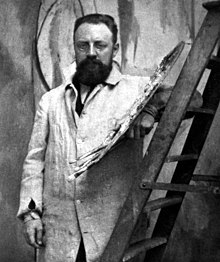 Matisse in 1913 Matisse in 1913 | |
| Born | Henri Émile Benoît Matisse (1869-12-31)31 December 1869 Le Cateau-Cambrésis, France |
| Died | 3 November 1954(1954-11-03) (aged 84) Nice, France |
| Education | Académie Julian, William-Adolphe Bouguereau, Gustave Moreau |
| Known for |
|
| Notable work | Woman with a Hat (1905) The Joy of Life (1906) Nu bleu (1907) La Danse (1909) L'Atelier Rouge (1911) The Snail (1953) |
| Movement | Fauvism, Modernism, Post-Impressionism |
| Spouse |
Amélie Noellie Parayre
(m. 1898; div. 1939) |
| Children | 3 |
| Patron(s) | Sergei Shchukin, Gertrude Stein, Etta Cone, Claribel Cone, Sarah Stein, Albert C. Barnes |
| Signature | |
Henri Émile Benoît Matisse (French: [ɑ̃ʁi emil bənwa matis]; 31 December 1869 – 3 November 1954) was a French visual artist, known for both his use of colour and his fluid and original draughtsmanship. He was a draughtsman, printmaker, and sculptor, but is known primarily as a painter.
Matisse is commonly regarded, along with Pablo Picasso, as one of the artists who best helped to define the revolutionary developments in the visual arts throughout the opening decades of the twentieth century, responsible for significant developments in painting and sculpture.
The intense colourism of the works he painted between 1900 and 1905 brought him notoriety as one of the Fauves (French for "wild beasts"). Many of his finest works were created in the decade or so after 1906, when he developed a rigorous style that emphasized flattened forms and decorative pattern. In 1917, he relocated to a suburb of Nice on the French Riviera, and the more relaxed style of his work during the 1920s gained him critical acclaim as an upholder of the classical tradition in French painting. After 1930, he adopted a bolder simplification of form. When ill health in his final years prevented him from painting, he created an important body of work in the medium of cut paper collage.
His mastery of the expressive language of colour and drawing, displayed in a body of work spanning over a half-century, won him recognition as a leading figure in modern art.
Early life and education

Matisse was born in Le Cateau-Cambrésis, in the Nord department in Northern France on New Year's Eve in 1869, the oldest son of a wealthy grain merchant. He grew up in Bohain-en-Vermandois, Picardie. In 1887, he went to Paris to study law, working as a court administrator in Le Cateau-Cambrésis after gaining his qualification. He first started to paint in 1889, after his mother brought him art supplies during a period of convalescence following an attack of appendicitis. He discovered "a kind of paradise" as he later described it, and decided to become an artist, deeply disappointing his father.
In 1891, he returned to Paris to study art at the Académie Julian under William-Adolphe Bouguereau and at the École Nationale des Beaux-Arts under Gustave Moreau. Initially he painted still lifes and landscapes in a traditional style, at which he achieved reasonable proficiency. Matisse was influenced by the works of earlier masters such as Jean-Baptiste-Siméon Chardin, Nicolas Poussin, and Antoine Watteau, as well as by modern artists, such as Édouard Manet, and by Japanese art. Chardin was one of the painters Matisse most admired; as an art student he made copies of four of Chardin's paintings in the Louvre.
In 1896, Matisse, an unknown art student at the time, visited the Australian painter John Russell on the island of Belle Île off the coast of Brittany. Russell introduced him to Impressionism and to the work of Vincent van Gogh—who had been a friend of Russell—and gave him a Van Gogh drawing. Matisse's style changed completely: abandoning his earth-coloured palette for bright colours. He later said Russell was his teacher, and that Russell had explained colour theory to him. The same year, Matisse exhibited five paintings in the salon of the Société Nationale des Beaux-Arts, two of which were purchased by the state.

With the model Caroline Joblau, he had a daughter, Marguerite, born in 1894. In 1898, he married Amélie Noellie Parayre; the two raised Marguerite together and had two sons, Jean (born 1899) and Pierre (born 1900). Marguerite and Amélie often served as models for Matisse.
In 1898, on the advice of Camille Pissarro, he went to London to study the paintings of J. M. W. Turner and then went on a trip to Corsica. Upon his return to Paris in February 1899, he worked beside Albert Marquet and met André Derain, Jean Puy, and Jules Flandrin. Matisse immersed himself in the work of others and went into debt from buying work from painters he admired. The work he hung and displayed in his home included a plaster bust by Rodin, a painting by Gauguin, a drawing by Van Gogh, and Cézanne's Three Bathers. In Cézanne's sense of pictorial structure and colour, Matisse found his main inspiration.
Many of Matisse's paintings from 1898 to 1901 make use of a Divisionist technique he adopted after reading Paul Signac's essay, "D'Eugène Delacroix au Néo-impressionisme".
In May 1902, Amélie's parents became ensnared in a major financial scandal, the Humbert Affair. Her mother (who was the Humbert family's housekeeper) and father became scapegoats in the scandal, and her family was menaced by angry mobs of fraud victims. According to art historian Hilary Spurling, "their public exposure, followed by the arrest of his father-in-law, left Matisse as the sole breadwinner for an extended family of seven." During 1902 to 1903, Matisse adopted a style of painting that was comparatively somber and concerned with form, a change possibly intended to produce saleable works during this time of material hardship. Having made his first attempt at sculpture, a copy after Antoine-Louis Barye, in 1899, he devoted much of his energy to working in clay, completing The Slave in 1903.
Early paintings
-
 Gustave Moreau's Studio, 1894–1895
Gustave Moreau's Studio, 1894–1895
-
 Blue Pot and Lemon (1897), Hermitage Museum, St. Petersburg, Russia
Blue Pot and Lemon (1897), Hermitage Museum, St. Petersburg, Russia
-
 Le Mur Rose, 1898, Jewish Museum Frankfurt
Le Mur Rose, 1898, Jewish Museum Frankfurt
-
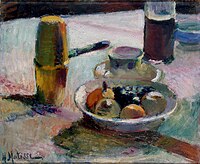 Fruit and Coffeepot (1898), Hermitage Museum, St. Petersburg, Russia
Fruit and Coffeepot (1898), Hermitage Museum, St. Petersburg, Russia
-
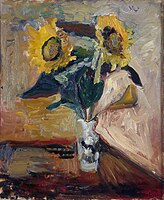 Vase of Sunflowers (1898), Hermitage Museum, St. Petersburg, Russia
Vase of Sunflowers (1898), Hermitage Museum, St. Petersburg, Russia
-
 Study of a Nude, 1899, Bridgestone Museum of Art, Tokyo
Study of a Nude, 1899, Bridgestone Museum of Art, Tokyo
-
 Still Life with Compote, Apples and Oranges, 1899, The Cone Collection, Baltimore Museum of Art
Still Life with Compote, Apples and Oranges, 1899, The Cone Collection, Baltimore Museum of Art
-
 Crockery on a Table (1900), Hermitage Museum, St. Petersburg, Russia
Crockery on a Table (1900), Hermitage Museum, St. Petersburg, Russia
Fauvism
Main article: Fauvism
Fauvism as a style began around 1900 and continued beyond 1910. The movement as such lasted only a few years, 1904–1908, and had three exhibitions. The leaders of the movement were Matisse and André Derain. Matisse's first solo exhibition was at Ambroise Vollard's gallery in 1904, without much success. His fondness for bright and expressive colour became more pronounced after he spent the summer of 1904 painting in St. Tropez with the neo-Impressionists Signac and Henri-Edmond Cross. In that year, he painted the most important of his works in the neo-Impressionist style, Luxe, Calme et Volupté. In 1905, he travelled southwards again to work with André Derain at Collioure. His paintings of this period are characterised by flat shapes and controlled lines, using pointillism in a less rigorous way than before.
Matisse and a group of artists now known as "Fauves" exhibited together in a room at the Salon d'Automne in 1905. The paintings expressed emotion with wild, often dissonant colours, without regard for the subject's natural colours. Matisse showed Open Window and Woman with the Hat at the Salon. Critic Louis Vauxcelles commented on a lone sculpture surrounded by an "orgy of pure tones" as "Donatello chez les fauves" (Donatello among the wild beasts), referring to a Renaissance-type sculpture that shared the room with them. His comment was printed on 17 October 1905 in Gil Blas, a daily newspaper, and passed into popular usage. The exhibition garnered harsh criticism—"A pot of paint has been flung in the face of the public", said the critic Camille Mauclair—but also some favourable attention. When the painting that was singled out for special condemnation, Matisse's Woman with a Hat, was bought by Gertrude and Leo Stein, the embattled artist's morale improved considerably.

Matisse was recognised as a leader of the Fauves, along with André Derain; the two were friendly rivals, each with his own followers. Other members were Georges Braque, Raoul Dufy, and Maurice de Vlaminck. The Symbolist painter Gustave Moreau (1826–1898) was the movement's inspirational teacher. As a professor at the École des Beaux-Arts in Paris, he pushed his students to think outside of the lines of formality and to follow their visions.
In 1907, Guillaume Apollinaire, commenting about Matisse in an article published in La Falange, wrote, "We are not here in the presence of an extravagant or an extremist undertaking: Matisse's art is eminently reasonable." But Matisse's work of the time also encountered vehement criticism, and it was difficult for him to provide for his family. His painting Nu bleu (1907) was burned in effigy at the Armory Show in Chicago in 1913.
The decline of the Fauvist movement after 1906 did not affect the career of Matisse; many of his finest works were created between 1906 and 1917, when he was an active part of the great gathering of artistic talent in Montparnasse, even though he did not quite fit in, with his conservative appearance and strict bourgeois work habits. He continued to absorb new influences. He travelled to Algeria in 1906 studying African art and Primitivism. After viewing a large exhibition of Islamic art in Munich in 1910, he spent two months in Spain studying Moorish art. He visited Morocco in 1912 and again in 1913 and while painting in Tangier he made several changes to his work, including his use of black as a colour. The effect on Matisse's art was a new boldness in the use of intense, unmodulated colour, as in L'Atelier Rouge (1911).
Matisse had a long association with the Russian art collector Sergei Shchukin. He created one of his major works La Danse specially for Shchukin as part of a two painting commission, the other painting being Music (1910). An earlier version of La Danse (1909) is in the collection of The Museum of Modern Art in New York City.
Selected works: Paris, 1901–1910
-
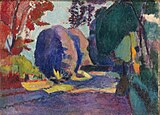 Luxembourg Gardens, 1901, Hermitage Museum, St. Petersburg, Russia
Luxembourg Gardens, 1901, Hermitage Museum, St. Petersburg, Russia
-
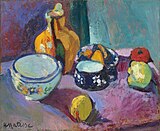 Dishes and Fruit, 1901, Hermitage Museum, St. Petersburg, Russia
Dishes and Fruit, 1901, Hermitage Museum, St. Petersburg, Russia
-
 A Glimpse of Notre-Dame in the Late Afternoon, 1902, Albright–Knox Art Gallery, Buffalo, New York
A Glimpse of Notre-Dame in the Late Afternoon, 1902, Albright–Knox Art Gallery, Buffalo, New York
-
 Nu (Carmelita), 1904, Museum of Fine Arts, Boston
Nu (Carmelita), 1904, Museum of Fine Arts, Boston
-
 Luxe, Calme et Volupté, 1904, Musée d'Orsay, Paris, France
Luxe, Calme et Volupté, 1904, Musée d'Orsay, Paris, France
-
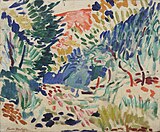 Landscape at Collioure, 1905, Museum of Modern Art, New York City
Landscape at Collioure, 1905, Museum of Modern Art, New York City
-
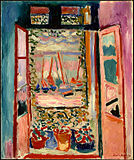 Open Window, Collioure, 1905, National Gallery of Art, Washington, D.C.
Open Window, Collioure, 1905, National Gallery of Art, Washington, D.C.
-
 Portrait of Madame Matisse (The green line), 1905, Statens Museum for Kunst, Copenhagen, Denmark
Portrait of Madame Matisse (The green line), 1905, Statens Museum for Kunst, Copenhagen, Denmark
-
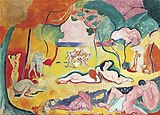 Le bonheur de vivre, 1905–6, Barnes Foundation, Philadelphia, Pennsylvania
Le bonheur de vivre, 1905–6, Barnes Foundation, Philadelphia, Pennsylvania
-
 Self-Portrait in a Striped T-shirt, 1906, Statens Museum for Kunst, Copenhagen, Denmark
Self-Portrait in a Striped T-shirt, 1906, Statens Museum for Kunst, Copenhagen, Denmark
-
 The Young Sailor II, 1906, Metropolitan Museum of Art, New York City
The Young Sailor II, 1906, Metropolitan Museum of Art, New York City
-
 Vase, Bottle and Fruit, 1906, Hermitage Museum, St. Petersburg, Russia
Vase, Bottle and Fruit, 1906, Hermitage Museum, St. Petersburg, Russia
-
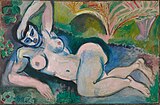 Blue Nude, 1907, Baltimore Museum of Art, Baltimore, Maryland
Blue Nude, 1907, Baltimore Museum of Art, Baltimore, Maryland
-
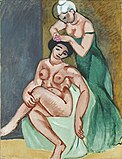 La coiffure, 1907, Staatsgalerie Stuttgart, Stuttgart, Germany
La coiffure, 1907, Staatsgalerie Stuttgart, Stuttgart, Germany
-
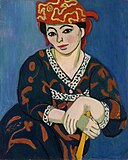 Madras Rouge, The Red Turban, 1907, Barnes Foundation, Philadelphia, Pennsylvania
Madras Rouge, The Red Turban, 1907, Barnes Foundation, Philadelphia, Pennsylvania
(Exhibited at the 1913 Armory Show) -
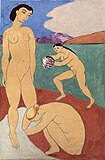 Le Luxe II, 1907–08, Statens Museum for Kunst, Copenhagen, Denmark
Le Luxe II, 1907–08, Statens Museum for Kunst, Copenhagen, Denmark
-
 Les trois baigneuses (Three Bathers), 1907, Minneapolis Institute of Art, Minneapolis
Les trois baigneuses (Three Bathers), 1907, Minneapolis Institute of Art, Minneapolis
-
 Bathers with a Turtle, 1908, Saint Louis Art Museum, St. Louis
Bathers with a Turtle, 1908, Saint Louis Art Museum, St. Louis
-
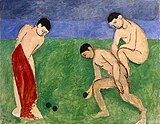 Game of Bowls, 1908, Hermitage Museum, St. Petersburg, Russia
Game of Bowls, 1908, Hermitage Museum, St. Petersburg, Russia
-
 La Danse (first version), 1909, Museum of Modern Art, New York City
La Danse (first version), 1909, Museum of Modern Art, New York City
-
 Still Life with Dance, 1909, Hermitage Museum, St. Petersburg, Russia
Still Life with Dance, 1909, Hermitage Museum, St. Petersburg, Russia
-
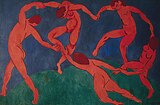 La Danse (second version), 1910, Hermitage Museum, St. Petersburg, Russia
La Danse (second version), 1910, Hermitage Museum, St. Petersburg, Russia
-
 Les Capucines (Nasturtiums with The Dance II), 1910–12, Pushkin Museum, Moscow, Russia
Les Capucines (Nasturtiums with The Dance II), 1910–12, Pushkin Museum, Moscow, Russia
-
 Music, 1910, Hermitage Museum, St. Petersburg, Russia
Music, 1910, Hermitage Museum, St. Petersburg, Russia
Sculpture

-
 Le Serf (The Serf, Der Sklave), 1900–1904, bronze
Le Serf (The Serf, Der Sklave), 1900–1904, bronze
-
 Sleep, 1905, wood, exhibition Blue Rose (Голубая Роза), 1907, location unknown
Sleep, 1905, wood, exhibition Blue Rose (Голубая Роза), 1907, location unknown
-
 Nu couché, I (Reclining Nude, I), 1906–07, bronze, exhibited at Montross Gallery, New York, 1915
Nu couché, I (Reclining Nude, I), 1906–07, bronze, exhibited at Montross Gallery, New York, 1915
-
 Awakening, 1907, plaster, exhibition Salon of the Golden Fleece (Салон Золотого Руна)
Awakening, 1907, plaster, exhibition Salon of the Golden Fleece (Салон Золотого Руна)
-
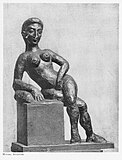 Figure décorative, 1908, bronze
Figure décorative, 1908, bronze
Gertrude Stein, Académie Matisse, and the Cone sisters

Around April 1906, Matisse met Pablo Picasso, who was 11 years his junior. The two became lifelong friends as well as rivals and are often compared. One key difference between them is that Matisse drew and painted from nature, while Picasso was more inclined to work from imagination. The subjects painted most frequently by both artists were women and still lifes, with Matisse more likely to place his figures in fully realised interiors. Matisse and Picasso were first brought together at the Paris salon of Gertrude Stein with her partner Alice B. Toklas. During the first decade of the twentieth century, the Americans in Paris—Gertrude Stein, her brothers Leo Stein, Michael Stein, and Michael's wife Sarah—were important collectors and supporters of Matisse's paintings. In addition, Gertrude Stein's two American friends from Baltimore, the Cone sisters Claribel and Etta, became major patrons of Matisse and Picasso, collecting hundreds of their paintings and drawings. The Cone collection is now exhibited in the Baltimore Museum of Art.

While numerous artists visited the Stein salon, many of these artists were not represented among the paintings on the walls at 27 rue de Fleurus. Where the works of Renoir, Cézanne, Matisse, and Picasso dominated Leo and Gertrude Stein's collection, Sarah Stein's collection particularly emphasised Matisse.
Contemporaries of Leo and Gertrude Stein, Matisse and Picasso became part of their social circle and routinely joined the gatherings that took place on Saturday evenings at 27 rue de Fleurus. Gertrude attributed the beginnings of the Saturday evening salons to Matisse, remarking:
More and more frequently, people began visiting to see the Matisse paintings—and the Cézannes: Matisse brought people, everybody brought somebody, and they came at any time and it began to be a nuisance, and it was in this way that Saturday evenings began.
Among Pablo Picasso's acquaintances who also frequented the Saturday evenings were Fernande Olivier (Picasso's mistress), Georges Braque, André Derain, the poets Max Jacob and Guillaume Apollinaire, Marie Laurencin (Apollinaire's mistress and an artist in her own right), and Henri Rousseau.
His friends organized and financed the Académie Matisse in Paris, a private and non-commercial school in which Matisse instructed young artists. It operated from 1907 until 1911. The initiative for the academy came from the Steins and the Dômiers, with the involvement of Hans Purrmann, Patrick Henry Bruce, and Sarah Stein.
Matisse spent seven months in Morocco from 1912 to 1913, producing about 24 paintings and numerous drawings. His frequent orientalist topics of later paintings, such as odalisques, can be traced to this period. Goldfish in aquariums also became a frequently recurring theme in Matisse's art following his trip to Morocco.
Selected works: Paris, 1910–1917
-
 Still Life with Geraniums, 1910, Pinakothek der Moderne, Munich, Germany
Still Life with Geraniums, 1910, Pinakothek der Moderne, Munich, Germany
-
 L'Atelier Rouge, 1911, The Museum of Modern Art, New York City
L'Atelier Rouge, 1911, The Museum of Modern Art, New York City
-
 The Conversation, c. 1911, The Hermitage, St. Petersburg, Russia
The Conversation, c. 1911, The Hermitage, St. Petersburg, Russia
-
 Window at Tangier, 1911–12, The Pushkin Museum of Fine Arts, Moscow
Window at Tangier, 1911–12, The Pushkin Museum of Fine Arts, Moscow
-
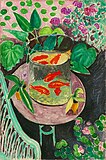 Goldfish, 1912, Pushkin Museum of Fine Arts, Moscow
Goldfish, 1912, Pushkin Museum of Fine Arts, Moscow
-
 Zorah on the Terrace, 1912, The Pushkin Museum of Fine Arts, Moscow
Zorah on the Terrace, 1912, The Pushkin Museum of Fine Arts, Moscow
-
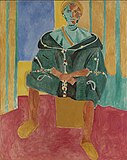 Le Rifain assis, 1912–13, 200 × 160 cm. Barnes Foundation
Le Rifain assis, 1912–13, 200 × 160 cm. Barnes Foundation
-
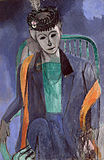 Portrait of the Artist's Wife, 1913, Hermitage Museum, Saint Petersburg
Portrait of the Artist's Wife, 1913, Hermitage Museum, Saint Petersburg
-
 La glace sans tain (The Blue Window), 1913, Museum of Modern Art
La glace sans tain (The Blue Window), 1913, Museum of Modern Art
-
 Woman on a High Stool, 1914, Museum of Modern Art, New York City
Woman on a High Stool, 1914, Museum of Modern Art, New York City
-
 View of Notre-Dame, 1914, Museum of Modern Art
View of Notre-Dame, 1914, Museum of Modern Art
-
 Les poissons rouges (Interior with a Goldfish Bowl), Musée National d'Art Moderne, Centre Georges Pompidou, Paris
Les poissons rouges (Interior with a Goldfish Bowl), Musée National d'Art Moderne, Centre Georges Pompidou, Paris
-
 French Window at Collioure, 1914. Musée National d'Art Moderne, Paris
French Window at Collioure, 1914. Musée National d'Art Moderne, Paris
-
 The Yellow Curtain, 1915, Museum of Modern Art, New York
The Yellow Curtain, 1915, Museum of Modern Art, New York
-
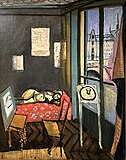 Studio, Quad Saint Michel, 1916, The Phillips Collection
Studio, Quad Saint Michel, 1916, The Phillips Collection
-
 Auguste Pellerin II, 1916–17, Musée National d'Art Moderne, Paris
Auguste Pellerin II, 1916–17, Musée National d'Art Moderne, Paris
-
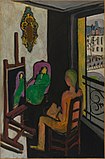 The Painter and His Model (Le Peintre dans son atelier), 1916–17, Musée National d'Art Moderne, Paris
The Painter and His Model (Le Peintre dans son atelier), 1916–17, Musée National d'Art Moderne, Paris
-
 Three Sisters and The Rose Marble Table (Les Trois sœurs à La Table de marbre rose), 1917, Barnes Foundation, Philadelphia
Three Sisters and The Rose Marble Table (Les Trois sœurs à La Table de marbre rose), 1917, Barnes Foundation, Philadelphia
-
 Portrait de famille (The Music Lesson), 1917, oil on canvas, 245.1 x 210.8 cm, Barnes Foundation
Portrait de famille (The Music Lesson), 1917, oil on canvas, 245.1 x 210.8 cm, Barnes Foundation
After Paris

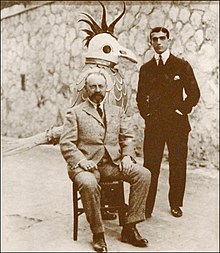

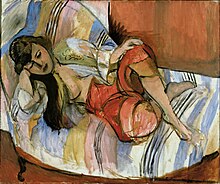
In 1917, Matisse relocated to Cimiez on the French Riviera, a suburb of the city of Nice. His work of the decade or so following this relocation shows a relaxation and softening of his approach. This "return to order" is characteristic of much post-World War I art, and can be compared with the neoclassicism of Picasso and Stravinsky as well as the return to traditionalism of Derain. Matisse's orientalist odalisque paintings are characteristic of the period; while this work was popular, some contemporary critics found it shallow and decorative.
In the late 1920s, Matisse once again engaged in active collaborations with other artists. He worked with not only Frenchmen, Dutch, Germans, and Spaniards, but also a few Americans and recent American immigrants.
After 1930, a new vigor and bolder simplification appeared in his work. American art collector Albert C. Barnes convinced Matisse to produce a large mural for the Barnes Foundation, The Dance II, which was completed in 1932; the Foundation owns several dozen other Matisse paintings. This move toward simplification and a foreshadowing of the cut-out technique is also evident in his painting Large Reclining Nude (1935). Matisse worked on this painting for several months and documented the progress with a series of 22 photographs, which he sent to Etta Cone.
World War II years
Matisse's wife Amélie, who suspected that he was having an affair with her young Russian emigre companion, Lydia Delectorskaya, ended their 41-year marriage in July 1939, dividing their possessions equally between them. Delectorskaya attempted suicide by shooting herself in the chest; remarkably, she survived with no serious after-effects, and returned to Matisse and worked with him for the rest of his life, running his household, paying the bills, typing his correspondence, keeping meticulous records, assisting in the studio, and coordinating his business affairs.
Matisse was visiting Paris when the Nazis invaded France in June 1940, but managed to make his way back to Nice. His son, Pierre, by then a gallery owner in New York, begged him to flee while he could. Matisse was about to depart for Brazil to escape the occupation of France but changed his mind and remained in Nice, in Vichy France. In September 1940, he wrote Pierre: "It seemed to me as if I would be deserting. If everyone who has any value leaves France, what remains of France?" Although he was never a member of the resistance, it became a point of pride to the occupied French that one of their most acclaimed artists chose to stay.
While the Nazis occupied France from 1940 to 1944, they were more lenient in their attacks on "degenerate art" in Paris than they were in the German-speaking nations under their military dictatorship. Matisse was allowed to exhibit, along with other former Fauves and Cubists whom Hitler had initially claimed to despise, although without any Jewish artists, all of whose works had been purged from all French museums and galleries; any French artists exhibiting in France had to sign an oath assuring their "Aryan" status, including Matisse. He also worked as a graphic artist and produced black-and-white illustrations for several books and over one hundred original lithographs at the Mourlot Studios in Paris.
In 1941, Matisse was diagnosed with duodenal cancer. The surgery, while successful, resulted in serious complications from which he nearly died. Being bedridden for three months resulted in his developing a new art form using paper and scissors.
That same year, a nursing student named Monique Bourgeois responded to an advertisement placed by Matisse for a nurse. A platonic friendship developed between Matisse and Bourgeois. He discovered that she was an amateur artist and taught her about perspective. After Bourgeois left the position to join a convent in 1944, Matisse sometimes contacted her to request that she model for him. Bourgeois became a Dominican nun in 1946, and Matisse painted a chapel in Vence, a small town he moved to in 1943, in her honor.
Matisse remained, for the most part, isolated in southern France throughout the war, but his family was intimately involved with the French resistance. His son Pierre, the art dealer in New York, helped the Jewish and anti-Nazi French artists he represented to escape occupied France and enter the United States. In 1942, Pierre held an exhibition in New York, "Artists in Exile", which was to become legendary. Matisse's estranged wife, Amélie, was a typist for the French Underground and jailed for six months. Matisse was shocked when he heard that his daughter Marguerite, who had been active in the Résistance during the war, was tortured (almost to death) by the Gestapo in a Rennes prison and sentenced to the Ravensbrück concentration camp in Germany. Marguerite managed to escape from the train to Ravensbrück, which was halted during an Allied air raid; she survived in the woods in the chaos of the closing days of the war until rescued by fellow resisters. Matisse's student Rudolf Levy was killed in the Auschwitz concentration camp in 1944.
Final years
Cut-outs
See also: Jazz (Henri Matisse)Diagnosed with abdominal cancer in 1941, Matisse underwent surgery that left him reliant on a wheelchair and often bedbound. Painting and sculpture had become physical challenges, so he turned to a new type of medium. With the help of his assistants, he began creating cut paper collages, or decoupage. He would cut sheets of paper, pre-painted with gouache by his assistants, into shapes of varying colours and sizes, and arrange them to form lively compositions. Initially, these pieces were modest in size, but eventually transformed into murals or room-sized works. The result was a distinct and dimensional complexity—an art form that was not quite painting, but not quite sculpture. He called the last fourteen years of his life "une seconde vie", meaning his second life. When talking about his work, Matisse mentioned that, while his mobility was limited, he could wander through gardens in the form of his artwork.
Although the paper cut-out was Matisse's major medium in the final decade of his life, his first recorded use of the technique was in 1919 during the design of decor for the Le chant du rossignol, an opera composed by Igor Stravinsky. Albert C. Barnes arranged for cardboard templates to be made of the unusual dimensions of the walls onto which Matisse, in his studio in Nice, fixed the composition of painted paper shapes. Another group of cut-outs were made between 1937 and 1938, while Matisse was working on the stage sets and costumes for Sergei Diaghilev's Ballets Russes. However, it was only after his operation that, bedridden, Matisse began to develop the cut-out technique as its own form, rather than its prior utilitarian origin.
He moved to the hilltop of Vence, France in 1943, where he produced his first major cut-out project for his artist's book titled Jazz. However, these cut-outs were conceived as designs for stencil prints to be looked at in the book, rather than as independent pictorial works. At this point, Matisse still thought of the cut-outs as separate from his principal art form. His new understanding of this medium unfolds with the 1946 introduction for Jazz. After summarizing his career, Matisse refers to the possibilities the cut-out technique offers, insisting "An artist must never be a prisoner of himself, prisoner of a style, prisoner of a reputation, prisoner of success…"
The number of independently conceived cut-outs steadily increased following Jazz, and eventually led to the creation of mural-size works, such as Oceania the Sky and Oceania the Sea of 1946. Under Matisse's direction, Lydia Delectorskaya, his studio assistant, loosely pinned the silhouettes of birds, fish, and marine vegetation directly onto the walls of the room. The two Oceania pieces, his first cut-outs of this scale, evoked a trip to Tahiti he made years before.
In May 1954, his cut out The Sheaf was exhibited at the Salon de Mai and met with success. The artwork was a commission for American collectors Mr and Mrs Brody and the cut out was then adapted to a ceramic for their house in Los Angeles. It is now located in the Los Angeles County Museum of Art.
Chapel and museum
In 1948, Matisse began to prepare designs for the Chapelle du Rosaire de Vence, which allowed him to expand this technique within a truly decorative context. The experience of designing the chapel windows, chasubles, and tabernacle door—all planned using the cut-out method—had the effect of consolidating the medium as his primary focus. Finishing his last painting in 1951 (and final sculpture the year before), Matisse utilized the paper cut-out as his sole medium for expression up until his death.
This project was the result of the close friendship between Matisse and Bourgeois, now Sister Jacques-Marie, despite him being an atheist. They had met again in Vence and started the collaboration, a story related in her book Henri Matisse: La Chapelle de Vence (1992) and in the documentary "A Model for Matisse" (2003).
In 1952, Matisse established a museum dedicated to his work, the Matisse Museum in Le Cateau, and this museum is now the third-largest collection of Matisse works in France.
According to David Rockefeller, Matisse's final work was the design for a stained-glass window installed at the Union Church of Pocantico Hills near the Rockefeller estate north of New York City: "It was his final artistic creation; the maquette was on the wall of his bedroom when he died in November of 1954." Installation was completed in 1956.
Death
Matisse died of a heart attack at the age of 84 on 3 November 1954. He is buried in the cemetery of the Monastère Notre Dame de Cimiez, in the Cimiez neighbourhood of Nice.
Legacy

The first painting of Matisse acquired by a public collection was Still Life with Geraniums (1910), exhibited in the Pinakothek der Moderne.
His The Plum Blossoms (1948) was purchased on 8 September 2005 for the Museum of Modern Art by Henry Kravis and the new president of the museum, Marie-Josée Drouin. Estimated price was $25 million. Previously, it had not been seen by the public since 1970. In 2002, a Matisse sculpture, Reclining Nude I (Dawn), sold for $9.2 million, a record for a sculpture by the artist.
Matisse's daughter Marguerite often aided Matisse scholars with insights about his working methods and his works. She died in 1982 while compiling a catalogue of her father's work.
Matisse's son Pierre Matisse (1900–1989) opened a modern art gallery in New York City during the 1930s. The Pierre Matisse Gallery, which was active from 1931 until 1989, represented and exhibited many European artists and a few Americans and Canadians in New York often for the first time. He exhibited Joan Miró, Marc Chagall, Alberto Giacometti, Jean Dubuffet, André Derain, Yves Tanguy, Le Corbusier, Paul Delvaux, Wifredo Lam, Jean-Paul Riopelle, Balthus, Leonora Carrington, Zao Wou Ki, Sam Francis, and Simon Hantaï, sculptors Theodore Roszak, Raymond Mason, and Reg Butler, and several other important artists, including the work of Henri Matisse.
Henri Matisse's grandson Paul Matisse is an artist and inventor living in Massachusetts. Matisse's great-granddaughter Sophie Matisse is active as an artist. Les Heritiers Matisse functions as his official Estate. The U.S. copyright representative for Les Heritiers Matisse is the Artists Rights Society.
The Musée Matisse in Nice, a municipal museum, has one of the world's largest collections of Matisse's works, tracing his artistic beginnings and his evolution through to his last works. The museum, which opened in 1963, is located in the Villa des Arènes, a seventeenth-century villa in the neighbourhood of Cimiez.
A crater on the planet Mercury was named in Matisse's honor.
Nazi-looted art
Numerous artworks by Matisse were seized by the Nazis or looted from Jewish collectors or changed hands in forced sales during the Nazi years. In the past twenty years, several artworks by Matisse have been restituted to the heirs of their pre-Third Reich owners, including Le Mur Rose, from France's Pompidou Museum to the heirs of Henry Fuld, "Femme Assise", discovered in the stash of Hildebrand Gurlitt's son in Munich, La vallée de la Stour, which had belonged to Anna Jaffé, found in the La Chaux-de-Fonds Museum and many others.
The German Lost Art Foundation lists 38 artworks by Matisse in the Lost Art Internet Database.
Recent exhibitions
Henri Matisse: The Cut-Outs was exhibited at London's Tate Modern, from April to September 2014. The show was the largest and most extensive of the cut-outs ever mounted, including approximately 100 paper maquettes—borrowed from international public and private collections—as well as a selection of related drawings, prints, illustrated books, stained glass, and textiles. In total, the retrospective featured 130 works encompassing his practice from 1937 to 1954. The Tate Modern show was the first in its history to attract more than half a million people.
The show was then moved to New York's Museum of Modern Art, where it was on display from October 12, 2014, until February 10, 2015. The newly conserved cut-out, The Swimming Pool, which had not been exhibited for more than 20 years, returned to the galleries as the centerpiece of the exhibition.
In 2018, Matisse's work was exhibited alongside that of Joan Miró, Le Corbusier, Raymond Hains and Éric Sandillon at the Museum of Decorative Arts and Design in Riga, Latvia. This exhibition, titled "Colour of Gobelins: Contemporary Gobelins from the 'Mobilier national' collection in France," took place during the sixth edition of the Riga Textile Art.
From May 1 to September 10, 2022, the Museum of Modern Art exhibited Matisse's painting The Red Studio, along with "paintings and drawings closely related to The Red Studio".
Partial list of works
Main article: List of works by Henri Matisse- Woman Reading (1894), Musée National d'Art Moderne Paris
- Le Mur Rose (1898), Musée National d'Art Moderne
- Canal du Midi (1898), Thyssen-Bornemisza Museum
- Notre-Dame, une fin d'après-midi (1902), Albright-Knox Art Gallery, Buffalo, New York
- Luxe, Calme, et Volupté (1904), Musée National d'Art Moderne
- Green Stripe (1905)
- The Open Window (1905)
- Woman with a Hat (1905)
- Les toits de Collioure (1905)
- Landscape at Collioure (1905)
- Le bonheur de vivre (1906)
- The Young Sailor II (1906)
- Self-Portrait in a Striped T-shirt (1906)
- Madras Rouge (1907)
- Blue Nude (1907), Baltimore Museum of Art
- The Dessert: Harmony in Red (The Red Room) (1908)
- Bathers with a Turtle (1908), Saint Louis Art Museum, Missouri
- La Danse (1909)
- Still Life with Geraniums (1910)
- L'Atelier Rouge (1911)
- The Conversation (1908–1912)
- Zorah on the Terrace (1912)
- Goldfish (1912)
- Le Rifain assis (1912)
- Window at Tangier (1912)
- Le rideau jaune (the yellow curtain) (1915)
- The Window (1916), Detroit Institute of Arts, Michigan
- The Painter and His Model (1916–17)
- The Windshield, On the Road to Villacoublay (1917), Cleveland Museum of Art
- La leçon de musique (1917)
- Interior A Nice (1920)
- Festival of Flowers, Nice (1923), Cleveland Museum of Art
- Odalisque with Raised Arms (1923), National Gallery of Art, Washington, D.C.
- Yellow Odalisque (1926)
- The Dance II (1932), triptych mural (45 ft by 15 ft) in the Barnes Foundation of Philadelphia
- Robe violette et Anémones (1937)
- Woman in a Purple Coat (1937)
- Le Rêve de 1940 (the dream of 1940) (1940)
- La Blouse Roumaine (1940)
- Interior with an Etruscan Vase (1940), Cleveland Museum of Art
- Le Lanceur De Couteaux (1943)
- Annelies, White Tulips and Anemones (1944), Honolulu Museum of Art
- L'Asie (1946)
- Deux fillettes, fond jaune et rouge (1947)
- Jazz (1947)
- The Plum Blossoms (1948)
- Chapelle du Saint-Marie du Rosaire (1948–1951)
- Beasts of the Sea (1950)
- The Sorrows of the King (1952)
- Black Leaf on Green Background (1952)
- La Négresse (1952)
- Blue Nude II (1952)
- The Snail (1953)
- Le Bateau (1954) This gouache created a minor stir when the MoMA mistakenly displayed it upside-down for 47 days in 1961.
Illustrations
- Jean Cocteau, Bertrand Guégan (1892–1943); L'almanach de Cocagne pour l'an 1920–1922, Dédié aux vrais Gourmands Et aux Francs Buveurs
Writings
- Notes of a Painter ("Note d'un peintre"), 1908
- Painter's Notes on Drawing ("Notes d'un peintre sur son dessin"), July 1939
- Jazz, 1947
- Matisse on Art, collected by Jack D. Flam, 1973, ISBN 0-7148-1518-7
- Chatting with Henri Matisse: The Lost 1941 Interview, Getty Publications, 2013, ISBN 978-1-60606-128-2
Portrayal in media and literature
Film dramatisations
- A film called Masterpiece, about the artist and his relationship with Monique Bourgeois, was proposed in 2011. Deepa Mehta intended to direct with Al Pacino to play Henri Matisse.
- Matisse was played by Yves-Antoine Spoto in the 2011 film Midnight in Paris.
- Matisse was portrayed by Joss Ackland in the 1996 Merchant Ivory production of Surviving Picasso.
Literature
- The Ray Bradbury short story "The Watchful Poker Chip of H. Matisse" contains an allusion to the artist painting an eye on a poker chip for an American man to use as a monocle.
- In Michael Ondaatje's Running in the Family, there is a section called 'Don't talk to me about Matisse'
- In Henry Miller's Tropic of Cancer there are multiple pages lionizing the works and importance of "the bright sage" Matisse, his hero.
Music
- The British composer Peter Seabourne wrote a septet "The Sadness of the King" (2007) inspired by the late paper cut La Tristesse du Roi.
References
Notes
- Myers, Terry R. (July–August 2010). "Matisse-on-the-Move". The Brooklyn Rail.
- "Tate Modern: Matisse Picasso". Tate.org.uk. Retrieved 13 February 2010.
- Adrian Searle (7 May 2002). "Searle, Adrian, A momentous, tremendous exhibition, The Guardian, Tuesday 7 May 2002". Guardian. UK. Retrieved 13 February 2010.
- "Trachtman, Paul, Matisse & Picasso, Smithsonian, February 2003". Smithsonianmag.com. Retrieved 13 February 2010.
- "Duchamp's urinal tops art survey". news.bbc.co.uk. 1 December 2004. Retrieved 10 December 2010.
- Wattenmaker, Richard J.; Distel, Anne, et al. (1993). Great French Paintings from the Barnes Foundation. New York: Alfred A. Knopf. ISBN 0-679-40963-7. p. 272
- Magdalena Dabrowski Department of Nineteenth-Century, Modern, and Contemporary Art, The Metropolitan Museum of Art Source: Henri Matisse (1869–1954) | Thematic Essay | Heilbrunn Timeline of Art History | The Metropolitan Museum of Art Retrieved 30 June 2010.
- Spurling, Hilary (2000). The Unknown Matisse: A Life of Henri Matisse: The Early Years, 1869–1908. University of California Press, 2001. ISBN 0-520-22203-2. pp. 4–6
- Leymarie, Jean; Read, Herbert; Lieberman, William S. (1966), Henri Matisse, UCLA Art Council, p.9.
- ^ Bärbel Küster. "Arbeiten und auf niemanden hören." Süddeutsche Zeitung, 6 July 2007. (in German)
- ^ The Unknown Matisse, pp 352–553..., ABC Radio National, 8 June 2005
- Spurling, Hilary. The Unknown Matisse: A Life of Henri Matisse, the Early Years, 1869–1908. p.86. accessed online 15 July 2007
- Spurling (1998), 119–138.
- ^ interview with Hilary Spurling (8 June 2005). "The Unknown Matisse ... – Book Talk". ABC Online. Retrieved 1 August 2016.
- Henri and Pierre Matisse, Cosmopolis, No 2, January 1999
- Spurling (1998), 138.
- Marguerite Matisse Retrieved 13 December 2010
- ^ Oxford Art Online, "Henri Matisse"
- ^ Leymarie, Jean; Read, Herbert; Lieberman, William S. (1966), Henri Matisse, UCLA Art Council, p.10.
- on page 23 of Google Books Link
- ^ Spurling, Hilary, 2005, "Matisse's Pajamas", The New York Review of Books, 11 August 2005, pp. 33–36.
- Leymarie, Jean; Read, Herbert; Lieberman, William S. (1966), Henri Matisse, UCLA Art Council, pp.19–20.
- ^ John Elderfield, The "Wild Beasts" Fauvism and Its Affinities, 1976, Museum of Modern Art, p.13, ISBN 0-87070-638-1
- Freeman, Judi, et al., The Fauve Landscape, 1990, Abbeville Press, p. 13, ISBN 1-55859-025-0.
- Vauxcelles, Louis. , Gil Blas, Supplément à Gil Blas du 17 octobre 1905, p.8, col.1, Salle VII (end). Retrieved from France Gallica, bibliothèque numérique (digital library), Bibliothèque nationale de France, 1 December 2013.
- ^ Chilver, Ian (Ed.). "Fauvism" Archived 9 November 2011 at the Wayback Machine, The Oxford Dictionary of Art, Oxford University Press, 2004. Retrieved from enotes.com, 26 December 2007.
- Picasso and Braque pioneering cubism, William Rubin, published by the Museum of Modern Art, New York, copyright 1989, ISBN 0-87070-676-4 p.348.
- Henri Matisse at the Encyclopædia Britannica
- ^ "Henri Matisse. The Moroccans. Issy-les-Moulineaux, late 1915 and fall 1916 – MoMA".
- "Matisse in Morocco".
- Review: John Russell, Matisse and the Mark Left On Him By Morocco, NY Times
- "Matisse, Luxe, calme et volupté, 1904, Musée d'Orsay, Paris, France". Archived from the original on 31 May 2013. Retrieved 14 April 2013.
- "Armory Show postcard with reproduction of Henri Matisse's painting the red turban, 1913, from the Walt Kuhn Family papers and Armory Show records, 1859-1984, bulk 1900-1949".
- "Three Bathers, 1907, oil on canvas, 60.3 x 73 cm, The Minneapolis Institute of Arts". Archived from the original on 7 April 2014. Retrieved 3 April 2014.
- The Guardian, Hillary Spurling on The Back Series
- "Henri Matisse. The Back (III). Issy-les-Moulineaux, by May 13, 1913 – early fall 1916 – MoMA".
- Tate. "Back I, Henri Matisse c. 1909–10, cast 1955–6 – Tate". Archived from the original on 21 May 2013. Retrieved 24 February 2013.
- Cone Collection Archived 19 October 2014 at the Wayback Machine, Baltimore Museum of Art. Retrieved 29 July 2007.
- (MoMA, 1970 at 28)
- Mellow, 1974, p. 84
- Mellow, 1974, p. 94-95
- Christopher Green, Art in France, 1900–1940, Pelican History of Art Series, Yale University Press, 2003, p. 64, ISBN 0300099088
- Cowart, Jack; Schneider, Pierre; Elderfield, John (1990). Matisse in Morocco: The Paintings and Drawings, 1912–1913.
- Wilkins, Charlotte (9 August 2015). "Matisse, Goldfish". Smarthistory. Retrieved 20 September 2022.
- "Henri Matisse Goldfish. 1912". Pushkin Museum. Retrieved 20 September 2022.
- Joseph, Charles M. (2002) "Stravinsky and Balanchine, A Journey of Invention", New Haven: Yale University Press. ISBN ML 410 S932 J6 652002
- Cowling, Elizabeth; Jennifer Mundy (1990). On Classic Ground: Picasso, Léger, de Chirico and the New Classicism 1910-1930. London: Tate Gallery. pp. 14, 92, 184. ISBN 1-854-37043-X.
- Jack Cowart and Dominique Fourcade. Henri Matisse: The Early Years in Nice 1916–1930. Henry N. Abrams, Inc., 1986. p. 47. ISBN 978-0810914421.
- Henri Matisse Photographic documentation of 22 progressive states of Large Reclining Nude, 1935, The Jewish Museum Archived 29 May 2013 at the Wayback Machine
- "Biography of Henri Matisse". Archived from the original on 12 July 2016. Retrieved 26 October 2015.
- Kramer, Hilton (March 1992). "Art & politics in the Vichy period". newcriterion.com. Retrieved 3 November 2021.
- Pryce-Jones, David (1981). Paris in the Third Reich: A History of the German Occupation, 1940–1944. Holt, Rinehart & Winston. p. 220.
- Daniels, Patricia. "Matisse: A biography".
- Lacayo, Richard (3 November 2014), The Paper Chase. At MOMA, a dazzling display of Matisse's blissful "Cut-Outs", retrieved 9 April 2015
- Heftrig, Ruth; Olaf Peters; Barbara Maria Schellewald (2008), Kunstgeschichte im "Dritten Reich": Theorien, Methoden, Praktiken, Akademie Verlag, p. 429; Spurling, Hilary, Matisse the Master: A Life of Henri Matisse, the Conquest of Colour, 1909–1954, p.424.
- Gilbert, Martin (2002). The Routledge Atlas of the Holocaust. Psychology Press. p. 10. ISBN 978-0-415-28145-4.
- Ruhrberg, Karl (1986). Twentieth Century art: Painting and Sculpture in the Ludwig Museum. Rizzoli. p. 55. ISBN 978-0-8478-0755-0.
- Cotter, Holland (9 October 2014), "Wisps From an Old Man's Dreams 'Henri Matisse: The Cut-Outs,' a Victory Lap at MoMA", New York Times, retrieved 17 February 2015
- ^ MoMA (2014), Henri Matisse: The Cut-Outs, retrieved 19 February 2015
- Carelli, Francesco (2014). "'Painting with scissors': Matisse and creativity in illness". London Journal of Primary Care. 6 (4): 93. doi:10.1080/17571472.2014.11493424. ISSN 1757-1472. PMC 4238723. PMID 25949724.
- "5 Word-Famous Artists That Had Disabilities: Michelangelo, Goya, Klee..." Passionate People by Invacare. 5 June 2017. Retrieved 20 November 2021.
- ^ Elderfield, John (1978). The Cut-Outs of Henri Matisse. New York: George Braziller. pp. 8. ISBN 0-8076-0886-6.
- Matisse, Henri (2001). Jazz. New York: Prestel Publishing. p. 10. ISBN 3-7913-2392-X.
- Cotter, Holland (9 October 2014), "Wisps From an Old Man's Dreams 'Henri Matisse: The Cut-Outs,' a Victory Lap at MoMA", New York Times, retrieved 17 February 2015
- Matisse a second life. Hazan. 2005. p. 242.
- "Henri Matisse: La Gerbe". LACMA. Retrieved 26 September 2021.
- Elderfield, John (1978). The Cut-Outs of Henri Matisse. New York: George Braziller. pp. 9. ISBN 0-8076-0886-6.
- Bock-Weiss, Catherine (2009). Henri Matisse: Modernist Against the Grain. Penn State Press. p. 147. ISBN 978-0-271-03512-3.
Natural enough, since he was surrounded by priests and nuns during his later illnesses and while working on the Venice Chapel, even though he remained a convinced atheist.
- Berger, Joseph (29 September 2005). "Sister Jacques-Marie, Influence for Matisse's Rosary Chapel, Dies". The New York Times. Retrieved 27 July 2010.
- Valyo, Cheryl (30 June 2003). "French Professor Directs "Model for Matisse"". Carnegie Mellon Today. Retrieved 30 July 2007.
- Rockefeller, David. "It is a pleasure to welcome you to the Union Church of Pocantico Hills". Union Church of Pocantico Hills. Retrieved 30 July 2010.
- Schneider, Pierre (1984). Matisse. New York: George Braziller. p. 740. ISBN 0-500-09166-8.
- Butler, Desmond. "Art/Architecture; A Home for the Modern In a Time-Bound City", The New York Times, 10 November 2002. Retrieved 25 December 2007.
- The Modern Acquires a 'Lost' Matisse, The New York Times, 8 September 2005
- "Marguerite Duthuit, a Model In Art of Matisse, Her Father", New York Times, 3 April 1982
- Russell, John (1999). Matisse, Father & Son. New York: Harry N. Abrams. pp.387–389 ISBN 0-8109-4378-6
- Metropolitan Museum exhibition of works from the Pierre Matisse Gallery, accessed online 20 June 2007 Archived 19 February 2009 at the Wayback Machine
- Most frequently requested artists list of the Artists Rights Society Archived 6 February 2015 at the Wayback Machine
- "Musée Matisse de Nice Cimiez" (in French). Nice Trotter. Archived from the original on 13 February 2013. Retrieved 21 June 2011. on 22 March 2021
- "Matisse". Gazetteer of Planetary Nomenclature. IAU/NASA/USGS. Retrieved 22 August 2023.
- "Matisse looted by Nazis turned over to British charity".
- "Matisse From Gurlitt Collection Is Returned to Jewish Art Dealer's Heirs". www.lootedart.com. Retrieved 30 April 2021.
- "Une toile spoliée quitte la Chaux-de-Fonds après un long combat". www.lootedart.com. Tribune de Genève. Archived from the original on 1 May 2018. Retrieved 30 April 2021.
- "Lost Art Internet Database - Advanced Search". www.lostart.de. Archived from the original on 30 April 2021. Retrieved 30 April 2021.
- Henri Matisse: The Cut-Outs, Tate, archived from the original on 10 March 2015, retrieved 28 February 2015
- Henri Matisse: The Cut-Outs, Museum of Modern Art, retrieved 28 February 2015
- Henri Matisse exhibition is Tate's most successful art show, BBC, 15 September 2014, retrieved 28 February 2015
- Henri Matisse: The Cut-Outs, Museum of Modern Art, retrieved 28 February 2015
- ^ "Colour of Gobelins. Contemporary Gobelins from the "Mobilier national" collection in France - Art Museums". www.lnmm.lv. Retrieved 6 January 2024.
- ^ ""Gobelēnu krāsas"". laikraksts.com (in Latvian). Retrieved 6 January 2024.
- ^ Artdaily. "Museum of Decorative Arts and Design in Riga looks into the textile collection of Mobilier national". artdaily.cc. Retrieved 6 January 2024.
- ^ "В Риге проходит выставка французских гобеленов - Культура, искусство - Latvijas reitingi". reitingi.lv (in Russian). 1 June 2024. Retrieved 6 January 2024.
- Nan Robertson. "Modern Museum is Startled by Matisse Picture" New York Times, 5 December 1961.
- Notice WorldCat; sudoc; BnF Archived 3 June 2016 at the Wayback Machine. Engraved on wood and unpublished drawings of: Matisse, J. Marchand, R. Dufy, Sonia Lewitska, de Segonzac, Jean Émile Laboureur, Friesz, Marquet, Pierre Laprade, Signac, Louis Latapie, Suzanne Valadon, Henriette Tirman and others.
- Child, Ben (14 February 2011). "Al Pacino to play Henri Matisse". The Guardian. Retrieved 29 April 2012.
- "Etelä Suonem Sannomat" (PDF). Archived from the original (PDF) on 4 June 2019. Retrieved 4 June 2019.
Bibliography
- Barr, Alfred H. Jr (1951). Matisse: His Art and His Public. New York: The Museum of Modern Art. ISBN 978-0-87070-469-7.. Matisse, his art and his public at the Internet Archive.
- Berggruen, Olivier; Hollein, Max, eds. (2006). Henri Matisse: Drawing with Scissors: Masterpieces from the Late Years. Prestel Publishing. ISBN 978-3-7913-3473-8.
- Celdran, F.; Vidal y Plana, R.R. (2007). Triangle: Henri Matisse – Georgette Agutte – Marcel Sembat. Paris: Yvelinedition. ISBN 978-2-84668-131-5.
- Cowart, Jack; Fourcade, Dominique (1986). Henri Matisse: The Early Years in Nice 1916–1930. Henry N. Abrams, Inc. ISBN 978-0-8109-1442-1.
- Escholier, Raymond (1960). Matisse. A Portrait of the Artist and the Man. London: Faber & Faber.
- Gowing, Lawrence (1979). Matisse. New York: Oxford University Press. ISBN 0-19-520157-4.
- Finsen, Hanne; Coquio, Catherine; et al. (2005). Matisse: A Second Life. Hazan. ISBN 978-2-7541-0043-4.
- Lewis, David (January 2009). "Matisse and Byzantium, or, Mechanization Takes Command". Modernism/modernity. 16 (1): 51–59. doi:10.1353/mod.0.0047. S2CID 144631296.
- Russell, John (1999). Matisse, Father & Son. NYC: Harry N. Abrams. ISBN 0-8109-4378-6.
- Schneider, Pierre (1984). Matisse. New York: Rizzoli. ISBN 0-8478-0546-8.
- Spurling, Hilary (1998). The Unknown Matisse: A Life of Henri Matisse, Vol. 1, 1869–1908. London: Hamish Hamilton Ltd. ISBN 0-679-43428-3.
- Spurling, Hilary (2005). Matisse the Master: A Life of Henri Matisse, Vol. 2, The Conquest of Colour 1909–1954. London: Hamish Hamilton Ltd. ISBN 0-241-13339-4.
- Wright, Alastair (2006). Matisse and the Subject of Modernism. Princeton: Princeton University Press. ISBN 0-691-11830-2.
Further reading
- Berggruen, Olivier and Max Hollein, eds., Henri Matisse: Drawing with Scissors: Masterpieces from the Late Years, Prestel, 2006. ISBN 3791334735.
- Bois, Yve-Alain. Matisse in the Barnes Foundation, Philadelphia: The Barnes Foundation; New York and London: Thames & Hudson, 2016.
- Kampis, Antal, Matisse, Budapest, 1959.
- Marmer, Nancy, "Matisse and the Strategy of Decoration," Artforum, March 1966, pp. 28–33.
- Sooke, Alastair, Henry Matisse: A Second Life. Penguin, 2014.
- Müller, Markus, Henri Matisse: The Great Masters of Art, Hirmer Verlag GmbH, Munich 2017, ISBN 978-3-7774-2848-2.
- Murrell, Denise, Posing Modernity: The Black Model from Manet and Matisse to Today. New Haven and London: Yale University Press, 2018.
External links
- Matisse and his Cats
- Footage of Henri Matisse in Vence, France working on the New Chapel of Vence
- Henri Matisse: Life and Work 500 hi-res images
- Henri Matisse at the Museum of Modern Art
- Musée Matisse Nice
- The nude in Matisse
- Gelett Burgess, "The Wild Men of Paris, Matisse, Picasso and Les Fauves", Architectural Record, 1910
- Documenting the Gilded Age: New York City Exhibitions at the Turn of the 20th Century Archived 17 January 2015 at the Wayback Machine A New York Art Resources Consortium project. Matisse exhibition catalog, and photoarchive file of Young Sailor II.
- Henri Matisse in American public collections, on the French Sculpture Census website

- Barnes Foundation, Philadelphia
| Fauvism | ||
|---|---|---|
| Leaders |  | |
| Others | ||
| Paintings | ||
| Influences | ||
| Influenced | ||
| Related | ||
| Modernism | |||||||||
|---|---|---|---|---|---|---|---|---|---|
| Movements | |||||||||
| Literary arts |
| ||||||||
| Visual arts |
| ||||||||
| Performing arts |
| ||||||||
| Related |
| ||||||||
| ← Romanticism
Postmodernism →
| |||||||||
- Henri Matisse
- 1869 births
- 1954 deaths
- 19th-century French painters
- 19th-century French sculptors
- 19th-century French male artists
- 20th-century French painters
- 20th-century French male artists
- 20th-century French sculptors
- Académie Julian alumni
- Fauvism
- French atheists
- French collage artists
- French male painters
- French male sculptors
- 20th-century French printmakers
- Matisse family
- French Orientalist painters
- People from Le Cateau-Cambrésis
- French Post-impressionist painters
- School of Paris
- Modern printmakers